
- •Study Skills Workshop
- •1.1 An Introduction to the Whole Numbers
- •1.2 Adding Whole Numbers
- •1.3 Subtracting Whole Numbers
- •1.4 Multiplying Whole Numbers
- •1.5 Dividing Whole Numbers
- •1.6 Problem Solving
- •1.7 Prime Factors and Exponents
- •1.8 The Least Common Multiple and the Greatest Common Factor
- •1.9 Order of Operations
- •THINK IT THROUGH Education Pays
- •2.1 An Introduction to the Integers
- •THINK IT THROUGH Credit Card Debt
- •2.2 Adding Integers
- •THINK IT THROUGH Cash Flow
- •2.3 Subtracting Integers
- •2.4 Multiplying Integers
- •2.5 Dividing Integers
- •2.6 Order of Operations and Estimation
- •Cumulative Review
- •3.1 An Introduction to Fractions
- •3.2 Multiplying Fractions
- •3.3 Dividing Fractions
- •3.4 Adding and Subtracting Fractions
- •THINK IT THROUGH Budgets
- •3.5 Multiplying and Dividing Mixed Numbers
- •3.6 Adding and Subtracting Mixed Numbers
- •THINK IT THROUGH
- •3.7 Order of Operations and Complex Fractions
- •Cumulative Review
- •4.1 An Introduction to Decimals
- •4.2 Adding and Subtracting Decimals
- •4.3 Multiplying Decimals
- •THINK IT THROUGH Overtime
- •4.4 Dividing Decimals
- •THINK IT THROUGH GPA
- •4.5 Fractions and Decimals
- •4.6 Square Roots
- •Cumulative Review
- •5.1 Ratios
- •5.2 Proportions
- •5.3 American Units of Measurement
- •5.4 Metric Units of Measurement
- •5.5 Converting between American and Metric Units
- •Cumulative Review
- •6.2 Solving Percent Problems Using Percent Equations and Proportions
- •6.3 Applications of Percent
- •6.4 Estimation with Percent
- •6.5 Interest
- •Cumulative Review
- •7.1 Reading Graphs and Tables
- •THINK IT THROUGH The Value of an Education
- •Cumulative Review
- •8.1 The Language of Algebra
- •8.2 Simplifying Algebraic Expressions
- •8.3 Solving Equations Using Properties of Equality
- •8.4 More about Solving Equations
- •8.5 Using Equations to Solve Application Problems
- •8.6 Multiplication Rules for Exponents
- •Cumulative Review
- •9.1 Basic Geometric Figures; Angles
- •9.2 Parallel and Perpendicular Lines
- •9.3 Triangles
- •9.4 The Pythagorean Theorem
- •9.5 Congruent Triangles and Similar Triangles
- •9.6 Quadrilaterals and Other Polygons
- •9.7 Perimeters and Areas of Polygons
- •THINK IT THROUGH Dorm Rooms
- •9.8 Circles
- •9.9 Volume
- •Cumulative Review
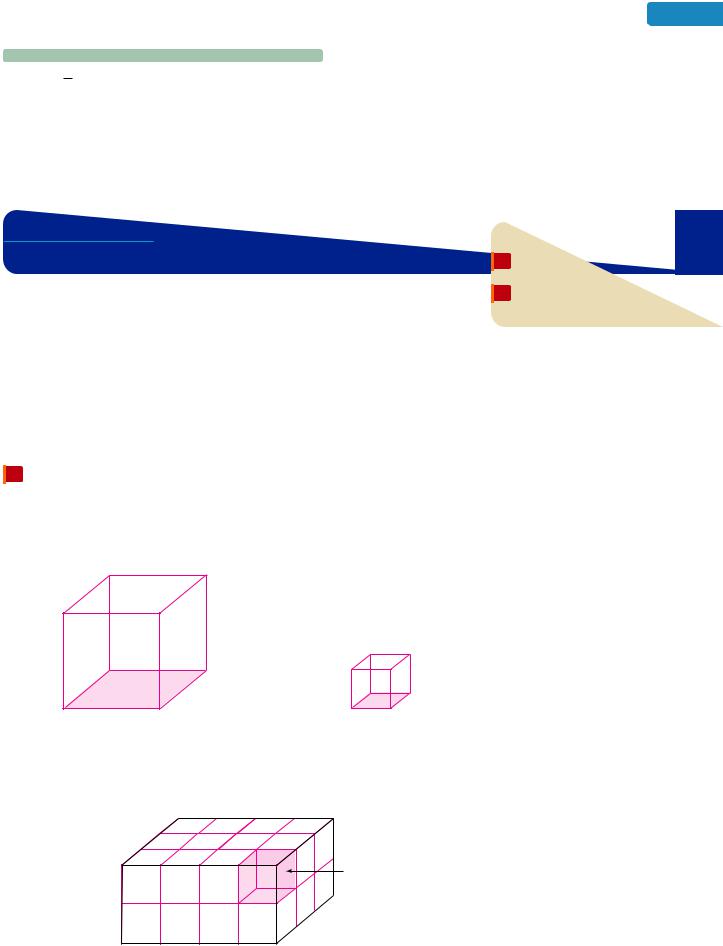
 REVIEW
REVIEW
65.Write 109 as a percent.
66.Write 78 as a percent.
67.Write 0.827 as a percent.
68.Write 0.036 as a percent.
69.UNIT COSTS A 24-ounce package of green beans sells for $1.29. Give the unit cost in cents per ounce.
9.9 Volume |
801 |
70.MILEAGE One car went 1,235 miles on 51.3 gallons of gasoline, and another went 1,456 on 55.78 gallons. Which car got the better gas mileage?
71.How many sides does a pentagon have?
72.What is the sum of the measures of the angles of a triangle?
S E C T I O N 9.9
Volume
We have studied ways to calculate the perimeter and the area of two-dimensional figures that lie in a plane, such as rectangles, triangles, and circles. Now we will consider three-dimensional figures that occupy space, such as rectangular solids, cylinders, and spheres. In this section, we will introduce the vocabulary associated with these figures as well as the formulas that are used to find their volume. Volumes are measured in cubic units, such as cubic feet, cubic yards, or cubic centimeters. For example,
• We measure the capacity of a refrigerator in cubic feet.
• We buy gravel or topsoil by the cubic yard.
• We often measure amounts of medicine in cubic centimeters.
1 Find the volume of rectangular solids, prisms, and pyramids.
The volume of a three-dimensional figure is a measure of its capacity. The following illustration shows two common units of volume: cubic inches, written as in.3, and cubic centimeters, written as cm3.
1 cubic inch: 1 in.3
1 cubic centimeter: 1 cm3
1 in.
1 cm
1 in.
1 cm
1 in. |
1 cm |
The volume of a figure can be thought of as the number of cubic units that will fit within its boundaries. If we divide the figure shown in black below into cubes, each cube represents a volume of 1 cm3. Because there are 2 levels with 12 cubes on each level, the volume of the prism is 24 cm3.
Objectives
1Find the volume of rectangular solids, prisms, and pyramids.
2Find the volume of cylinders, cones, and spheres.
1 cm3
2 cm
3 cm
4 cm

802 |
Chapter 9 An Introduction to Geometry |
 Self Check 1
Self Check 1
How many cubic centimeters are in 1 cubic meter?
Now Try Problem 25
EXAMPLE 1 How many cubic inches are there in 1 cubic foot?
Strategy A figure is helpful to solve this problem.We will draw a cube and divide each of its sides into 12 equally long parts.
WHY Since a cubic foot is a cube with each side measuring 1 foot, each side also measures 12 inches.
Solution The figure on the right helps us understand the situation. Note that each level of the cubic foot contains 12 12 cubic inches
and that the cubic foot has 12 levels. We can 1 ft 12 in. 
 use multiplication to count the number of
use multiplication to count the number of 

cubic inches contained in the figure.There are
12 12 12 1,728
cubic inches in 1 cubic foot. Thus, 1 ft3 1,728 in.3.
Cube |
Rectangular Solid |
12 in.
1 ft
Sphere
s
s
s
V s3
where s is the length of a side
Prism
|
|
|
|
|
|
r |
|
h |
|
|
|
|
|
||
|
|
|
|
||||
|
w |
|
|
|
|||
|
l |
|
|
|
|||
V lwh |
V |
4 |
pr3 |
||||
3 |
|||||||
|
|
|
|
|
|
||
where l is the length, w is |
where r is the radius |
||||||
the width, and h is the height
Pyramid
h |
h |
h |
h |
|
|||
|
|
|
V Bh
where B is the area of the base and h is the height
Cylinder
V 13 Bh
where B is the area of the base and h is the height
Cone
h |
|
|
|
|
|
|
|
|
h |
|
|
|
|
|
|
|
|
|
h |
||||||
|
h |
|
|
|
|
|
|
|
|
|
|
|
|
|
|
|
|||||||||
|
|
|
|
|
|
|
r |
|
|
r |
|
|
|
||||||||||||
|
|
r |
|
|
|
|
|
|
r |
|
|
|
|
|
|
|
|
|
|||||||
|
|
|
|
|
|
|
|
|
|
|
|
|
|
|
|
||||||||||
|
|
|
|
|
|
|
|
|
|
|
|
1 |
|
|
1 |
|
|
|
|
|
|
|
|||
|
|
|
|
|
|
|
|
|
|
|
|
|
|
|
|
|
|
|
|
|
|||||
|
|
|
V Bh or V pr2h |
|
V |
|
Bh or V |
pr2h |
|||||||||||||||||
|
|
|
3 |
3 |
|||||||||||||||||||||
|
|
|
|
|
|
|
|
|
|
|
|
|
|
|
|
|
|
|
|
|
|
|
|||
|
|
where B is the area of the base, |
where B is the area of the base, |
||||||||||||||||||||||
h is the height, and r is the radius of the base |
h is the height, and r is the radius of the base |
||||||||||||||||||||||||

In practice, we do not find volumes of three-dimensional figures by counting cubes. Instead, we use the formulas shown in the table on the preceding page. Note that several of the volume formulas involve the variable B. It represents the area of the base of the figure.
Caution! The height of a geometric solid is always measured along a line perpendicular to its base.
 Storage Tanks An oil storage tank is in the form of a rectangular solid with dimensions 17 feet by 10 feet by 8 feet. (See the figure below.) Find its volume.
Storage Tanks An oil storage tank is in the form of a rectangular solid with dimensions 17 feet by 10 feet by 8 feet. (See the figure below.) Find its volume.
9.9 Volume |
803 |
 Self Check 2
Self Check 2
Find the volume of a rectangular solid with dimensions 8 meters by 12 meters by 20 meters.
Now Try Problem 29
8 ft
10 ft
17 ft
Strategy We will substitute 17 for l , 10 for w, and 8 for h in the formula V lwh and evaluate the right side.
WHY The variable V represents the volume of a rectangular solid.
Solution
V lwh |
This is the formula for the volume of a rectangular solid. |
|
5 |
|
170 |
||
V 17(10)(8) |
Substitute 17 for l, the length, 10 for w, the width, and 8 |
|
8 |
1,360 |
|||
1,360 |
for h, the height of the tank. |
|
|
Do the multiplication. |
|
|
|
The volume of the tank is 1,360 ft3.
|
EXAMPLE 3 |
Find the volume of the prism |
|
|
|
|
|
|
10 cm |
|
|
|
|
||
|
|
|
|
|
|
||
shown on the right. |
|
|
|
|
|
||
Strategy First, we will find the area of the base |
|
|
|
50 cm |
|
||
of the prism. |
|
|
|
|
|
|
|
WHY To use the volume formula V Bh, we |
|
|
|
|
|
||
need to know B, the area of the prism’s base. |
|
|
|
|
|
||
Solution The area of the triangular base of the |
6 cm |
8 cm |
|
||||
|
|
||||||
prism is 21 (6)(8) 24 square centimeters. To find |
|
|
|
|
|
||
|
|
|
|
|
|||
its volume, we proceed as follows: |
|
|
|
|
|
||
|
V Bh |
This is the formula for the volume of a triangular prism. |
|
|
2 |
||
|
|
||||||
|
|
|
24 |
||||
|
V 24(50) |
Substitute 24 for B, the area of the base, and 50 for h, |
|
|
50 |
||
|
|
|
1,200 |
||||
|
|
the height. |
|
|
|
||
|
|
|
|
|
|
|
|
1,200 |
Do the multiplication. |
|
|
|
|
|
|
The volume of the triangular prism is 1,200 cm3.
Caution! Note that the 10 cm measurement was not used in the calculation of the volume.
 Self Check 3
Self Check 3
Find the volume of the prism shown below.
10 in.
12 in. |
5 in. |
Now Try Problem 33
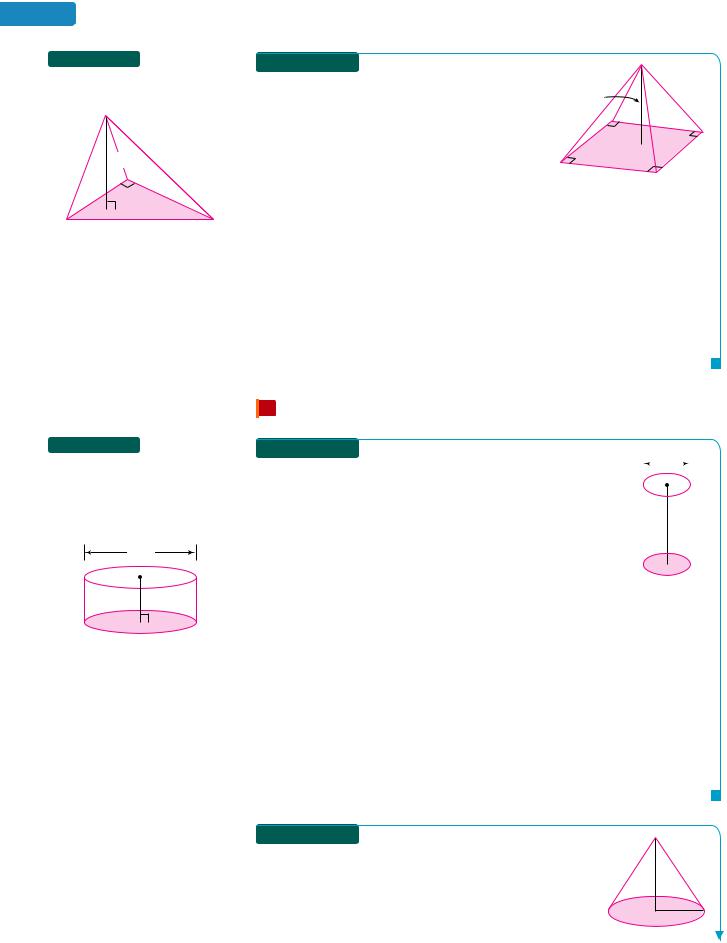
804 |
Chapter 9 An Introduction to Geometry |
 Self Check 4
Self Check 4
Find the volume of the pyramid shown below.
20 cm
|
cm |
16 |
cm |
|
|
||
12 |
|
|
|
|
|
|
Now Try Problem 37
|
EXAMPLE 4 |
Find the volume of the pyramid |
|
|
|
|
shown |
|
|
||
on the right. |
|
9 m |
|
|
|
Strategy First, we will find the area of the square |
|
|
|||
|
|
|
|||
base of the pyramid. |
|
|
|
|
|
WHY The volume of a pyramid is 31 of the product of |
|
|
6 m |
||
|
|
||||
|
|
||||
the area of its base and its height. |
6 m |
|
|
||
Solution Since the base is a square with each side |
|
|
|||
|
|
|
|||
6 meters long, the area of the base is (6 m)2, or 36 m2. To find the volume of the pyramid, we proceed as follows:
V |
1 |
Bh |
This is the formula for the volume of a pyramid. |
|
||||
3 |
|
|||||||
V |
1 |
(36)(9) |
Substitute 36 for B, the area of the base, and 9 for h, the height. |
|
||||
|
|
|||||||
3 |
|
|||||||
12(9) |
Multiply: |
1 |
(36) 36 12. |
|
1 |
|||
|
||||||||
|
12 |
|||||||
|
||||||||
|
|
|
3 |
3 |
|
9 |
||
108 |
Complete the multiplication. |
|
||||||
|
108 |
|||||||
|
|
|
|
|
|
|
||
The volume of the pyramid is 108 m3.
 Self Check 5
Self Check 5
Find the volume of the cylinder shown below. Give the exact answer and an approximation to the nearest hundredth.
10 yd
4 yd
Now Try Problem 45
2 Find the volume of cylinders, cones, and spheres.
|
EXAMPLE 5 |
Find the volume of the cylinder shown on the |
|
|
|
|
|
|
|
|
|
|
|
6 cm |
|
|
|||||
right. Give the exact answer and an approximation to the nearest |
|
|
|
|
|
|
|
|
||
|
|
|
|
|
|
|
|
|||
hundredth. |
|
|
|
|
|
|
|
|
|
|
|
|
|
|
|
|
|
|
|
||
Strategy First, we will find the radius of the circular base of the |
|
|
|
|
|
|
|
|
||
cylinder. |
|
|
|
|
|
10 cm |
|
|||
|
|
|
|
|
|
|
|
|
||
WHY To use the formula for the volume of a cylinder, V pr2h, |
|
|
|
|
|
|
|
|
||
we need to know r, the radius of the base. |
|
|
|
|
|
|
|
|
||
|
|
|
|
|
|
|
|
|||
Solution Since a |
|
|
|
|
|
|
|
|
|
|
radius is one-half of the diameter of the |
circular base, |
|||||||||
r 12 6 cm 3 cm. From the figure, we see that the height of the cylinder is 10 cm. To find the volume of the cylinder, we proceed as follows.
V pr2h |
This is the formula for the volume of a cylinder. |
V p(3)2(10) |
Substitute 3 for r, the radius of the base, |
|
and 10 for h, the height. |
V p(9)(10) |
Evaluate the exponential expression: (3)2 9. |
90p |
Multiply: (9)(10) 90. Write the product so |
|
that P is the last factor. |
282.7433388 |
Use a calculator to do the multiplication. |
The exact volume of the cylinder is 90p cm3. To the nearest hundredth, the volume is 282.74 cm3.
|
EXAMPLE 6 |
Find the volume of the cone shown on |
|
|
|
|
|
|
|
||
the right. Give the exact answer and an approximation to the |
|
|
|
||
nearest hundredth. |
|
|
6 ft |
||
Strategy We will substitute 4 for r and 6 for h in the formula |
|
||||
|
|
|
|||
V 31 pr2h and evaluate the right side. |
|
|
4 ft |
||
|
|
||||
|
|
|
|
|
|
WHY The variable V represents the volume of a cone.
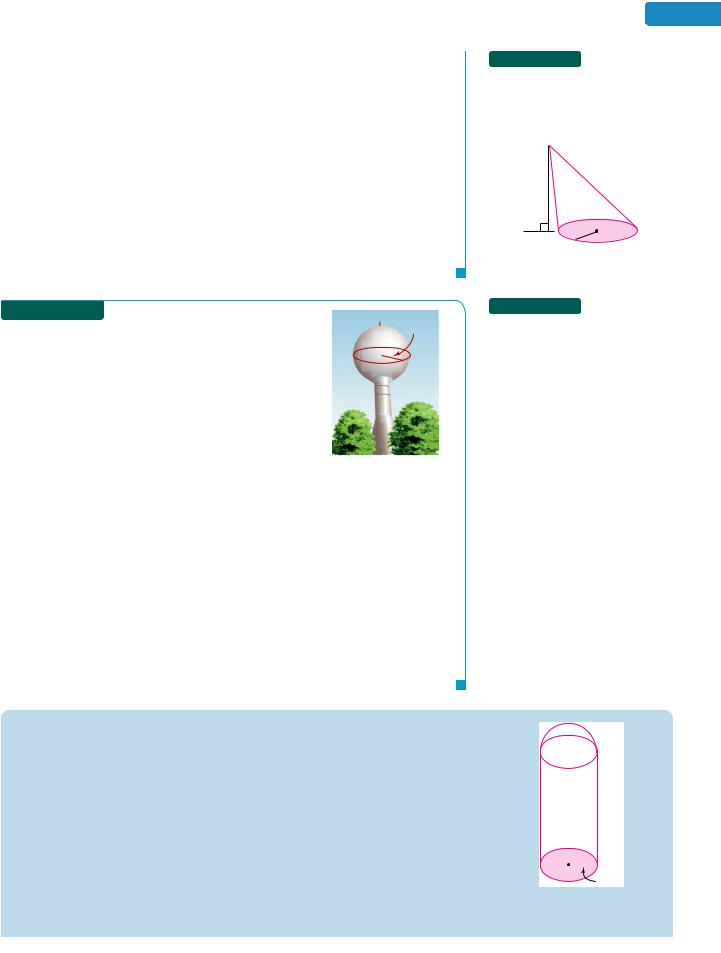
Solution
V |
1 |
pr2h |
This is the formula for the volume of a cone. |
|||
3 |
||||||
|
|
|
|
|
||
V |
1 |
p(4)2(6) |
Substitute 4 for r, the radius of the base, and 6 for h, the height. |
|||
3 |
||||||
|
|
|
|
|
||
|
1 |
p(16)(6) |
Evaluate the exponential expression: (4)2 16. |
|||
3 |
||||||
|
|
|
|
|
||
|
2p(16) |
Multiply: |
1 |
(6) 2. |
||
|
||||||
|
|
|
3 |
|
||
|
32p |
Multiply: 2(16) 32. Write the product so that P is the last factor. |
||||
|
100.5309649 |
Use a calculator to do the multiplication. |
||||
The exact volume of the cone is 32p ft3. To the nearest hundredth, the volume is 100.53 ft3.
|
EXAMPLE 7 |
Water Towers How many cubic |
15 ft |
|
feet of water are needed to fill the spherical water tank |
||||
|
||||
shown on the right? Give the exact answer and an |
|
|||
approximation to the nearest tenth. |
|
|||
Strategy We will substitute 15 for r in the formula
V 43 pr3 and evaluate the right side.
WHY The variable V represents the volume of a sphere.
Solution
V |
4 |
pr3 |
This is the formula for the volume of a sphere. |
|
|
|
|
3 |
|
|
|
||||
|
|
|
|
|
|
|
|
V |
4 |
p(15)3 |
Substitute 15 for r, the radius of the sphere. |
|
|
|
|
3 |
|
|
|
||||
|
|
|
|
|
|
|
|
|
4 |
p (3,375) |
Evaluate the exponential expression: (15)3 3,375. |
|
|
|
|
|
|
|
|
||||
3 |
|
|
|
||||
|
13,500 |
|
Multiply: 4(3,375) 13,500. |
|
1 3 2 |
||
|
|
|
|||||
|
|
|
p |
|
3375 |
||
3 |
|||||||
|
|
|
|
Divide: 13,500 4,500. Write the product |
|
4 |
|
|
4,500p |
|
|
13,500 |
|||
|
|||||||
|
|
|
|
3 |
|
|
|
|
|
|
|
so that P is the last factor. |
|
|
|
|
14,137.16694 |
Use a calculator to do the multiplication. |
|
|
|
||
The tank holds exactly 4,500p ft3 of water. To the nearest tenth, this is 14,137.2 ft3.
9.9 Volume |
805 |
 Self Check 6
Self Check 6
Find the volume of the cone shown below. Give the exact answer and an approximation to the nearest hundredth.
5 mi
2 mi
Now Try Problem 49
 Self Check 7
Self Check 7
Find the volume of a spherical water tank with radius 7 meters. Give the exact answer and an approximation to the nearest tenth.
Now Try Problem 53
Using Your CALCULATOR Volume of a Silo
A silo is a structure used for storing grain. The silo shown on the right is a cylinder 50 feet tall topped with a dome in the shape of a hemisphere. To find the volume of the silo, we add the volume of the cylinder to the volume of the dome.
|
|
|
|
|
|
|
|
|
1 |
|
|
|
|
50 ft |
|
Volumecylinder Volumedome (Areacylinder’s base)(Heightcylinder) |
|
(Volumesphere) |
|||||||||||||
2 |
|||||||||||||||
pr2h |
1 |
a |
4 |
pr3b |
|
|
|
|
|
|
|
||||
|
|
|
|
|
|
|
|
|
|||||||
|
2 |
3 |
3 |
|
|
|
|
|
|
|
|
|
|
||
|
|
|
|
|
|
|
|
|
|
|
|||||
|
2pr |
|
|
|
|
|
|
|
|
|
10 ft |
||||
pr2h |
|
|
Multiply and simplify: |
1 |
14 pr3 2 |
4 pr3 |
2pr3 . |
||||||||
|
3 |
|
|
||||||||||||
|
|
|
|
|
|
2 3 |
6 |
3 |
|
|
|||||
p(10)2 (50) |
2p(10)3 |
|
|
|
|
|
|
|
|||||||
|
Substitute 10 for r and 50 for h. |
||||||||||||||
3 |
|||||||||||||||
|
|
|
|
|
|
|
|
|
|
|
|
|
|
||
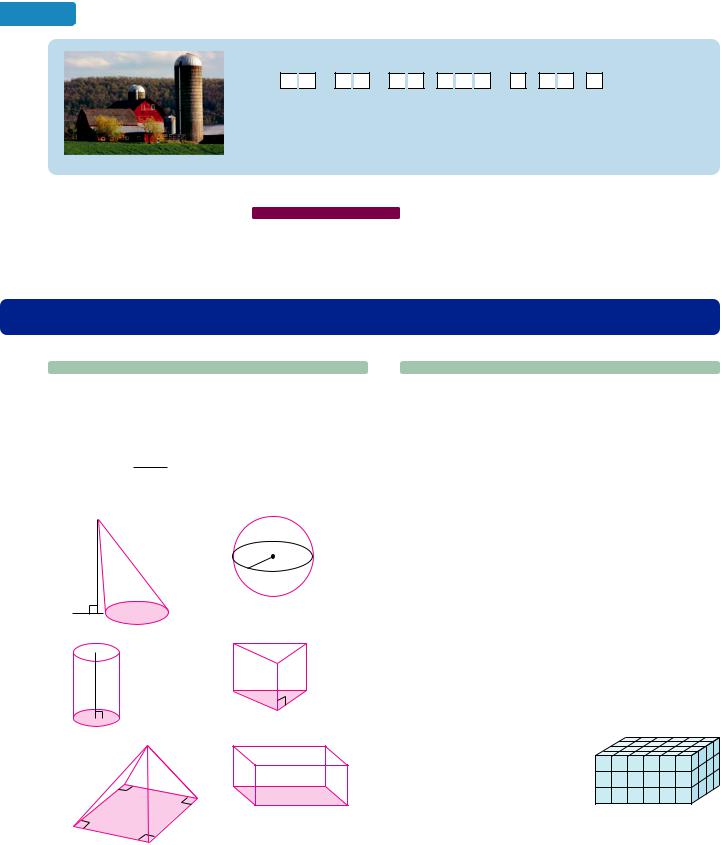
806 |
Chapter 9 An Introduction to Geometry |
|
|
|
|
|
|
|
We can use a scientific calculator to make this calculation.
p 
 10 x2
10 x2 
 50
50 
 ( 2
( 2 
 p
p 
 10 yx 3 )
10 yx 3 ) 
 3
3
iStockphoto.com/ VeithSherwood |
|
|
17802.35837 |
|
|
|
|
|
|
|
|
|
The volume of the silo is approximately 17,802 ft3. |
|
|||
© R. |
|
|
|
|
|
|
|
|
|
|
|
|
ANSWERS TO SELF CHECKS |
|
|
|
|
|
|
|
|
||
|
1. |
1,000,000 cm3 2. 1,920 m3 |
3. 300 in.3 4. 640 cm3 5. 100p yd3 314.16 yd3 |
|
|
|
6. |
203 p mi3 20.94 mi3 7. 1,3723 |
p m3 1,436.8 m3 |
|
|
|
|
|
|
|
|
|
S E C T I O N |
9.9 STUDY SET |
||||
|
|
VOCABULARY |
|
|||
|
|
|||||
|
|
|||||
|
Fill in the blanks. |
|
|
|
||
|
|
1. The |
|
|
of a three-dimensional figure is a |
|
measure of its capacity.
2. The volume of a figure can be thought of as the number of units that will fit within its boundaries.
Give the name of each figure.
3. 4.
5. 6.
7. 8.
 CONCEPTS
CONCEPTS
9.Draw a cube. Label a side s.
10.Draw a cylinder. Label the height h and radius r.
11.Draw a pyramid. Label the height h and the base.
12.Draw a cone. Label the height h and radius r.
13.Draw a sphere. Label the radius r.
14.Draw a rectangular solid. Label the length l , the width w, and the height h.
15.Which of the following are acceptable units with which to measure volume?
ft2 |
mi3 |
seconds |
days |
cubic inches |
mm |
square yards |
in. |
pounds |
cm2 |
meters |
m3 |
16.In the figure on the right, the unit of measurement of length used to draw the figure is the inch.
a.What is the area of the base of the figure?
b.What is the volume of the figure?

17.Which geometric concept (perimeter, circumference, area, or volume) should be applied when measuring each of the following?
a.The distance around a checkerboard
b.The size of a trunk of a car
c.The amount of paper used for a postage stamp
d.The amount of storage in a cedar chest
e.The amount of beach available for sunbathing
f.The distance the tip of a propeller travels
18.Complete the table.
Figure |
Volume formula |
|
|
Cube |
|
Rectangular solid |
|
Prism |
|
Cylinder |
|
Pyramid |
|
Cone |
|
Sphere |
|
|
|
19. Evaluate each expression. Leave p in the answer.
a. |
1 |
p(25)6 |
b. |
4 |
p(125) |
|
3 |
3 |
|||||
|
|
|
|
20.a. Evaluate 13 pr2h for r 2 and h 27. Leave p in the answer.
b.Approximate your answer to part a to the nearest tenth.
 NOTATION
NOTATION
21.a. What does “in.3” mean?
b. Write “one cubic centimeter” using symbols.
22.In the formula V 13 Bh, what does B represent?
23. In a drawing, what does the symbol indicate?
24.Redraw the figure below using dashed lines to show the hidden edges.
9.9 Volume |
807 |
 GUIDED PRACTICE
GUIDED PRACTICE
Convert from one unit of measurement to another.
See Example 1.
25.How many cubic feet are in 1 cubic yard?
26.How many cubic decimeters are in 1 cubic meter?
27.How many cubic meters are in 1 cubic kilometer?
28.How many cubic inches are in 1 cubic yard?
Find the volume of each figure. See Example 2.
29. 30.
7 ft
8 mm
2 ft
4 ft
10 mm |
4 mm |
31. 32.
|
5 in. |
|
|
40 ft |
|
|
5 in. |
|
5 in. |
40 ft |
|
40 ft |
||
|
Find the volume of each figure. See Example 3.
33. |
5 cm |
34. |
|
13 cm |
|
|
|
|
0.2 m |
|
|
0.8 m |
|
|
|
|
|
|
|
|
|
3 cm |
4 cm |
|
|
|
|
|
|
|
12 cm |
5 cm |
||
|
|
|
|
|
||
35. |
12 in. |
36. |
|
|
|
|
|
10 in. |
|
24 in. |
|||
|
|
|
||||
|
|
|
|
|
|
0.5 ft |
|
|
|
|
|
|
|
|
2 ft |
|
|
|
|
|
|
|
|
26 in. |
|
|
|
|
|
|
|
|
|
|
|
|
15 in. |
|
|
|
|
|
9 in. |
|
|
|
|
|
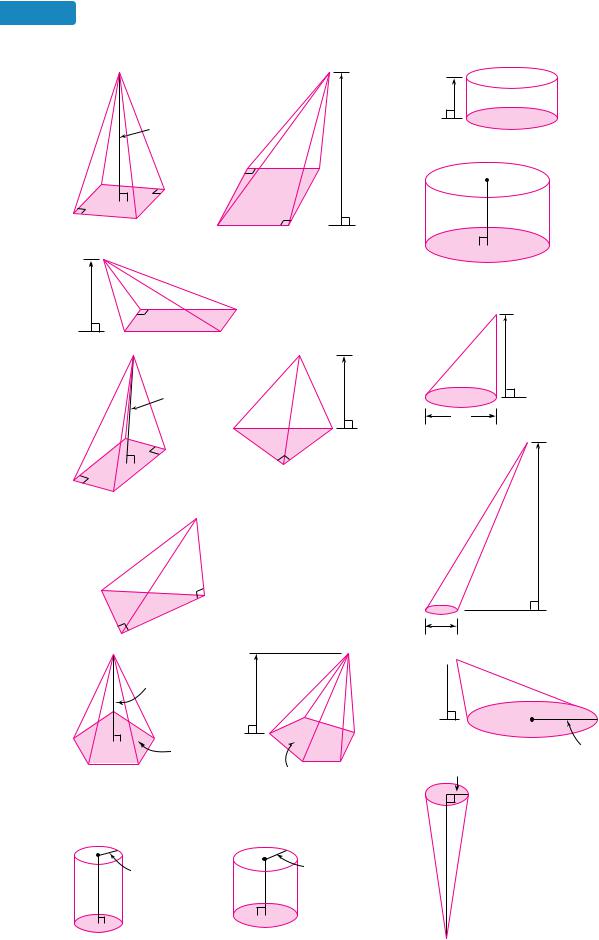
808 |
Chapter 9 An Introduction to Geometry |
Find the volume of each figure. See Example 4.
37. 38.
21 yd
15 m
7 m
10 yd
10 yd
7 m
39.
6 ft
2 ft
8 ft
40. 41.
7.0 ft
18 in.
7.2 ft |
8.3 ft |
13 in.
11 in.
42.
8.0 mm
4.8 mm
9.1 mm
43. 44.
2 yd
11 ft
Area of base
9 yd2
Area of base 33 ft2
Find the volume of each cylinder. Give the exact answer and an approximation to the nearest hundredth. See Example 5.
45. |
|
46. |
|
4 ft |
2 mi |
|
|
|
12 ft |
|
6 mi |
47. 30 cm
30 cm 

14 cm
48. 116 in.
116 in. 

60 in.
Find the volume of each cone. Give the exact answer and an approximation to the nearest hundredth. See Example 6.
49.
13 m
6 m
50.
21 mm
4mm
51.
7 yd
9 yd
52.5 ft
 30 ft
30 ft
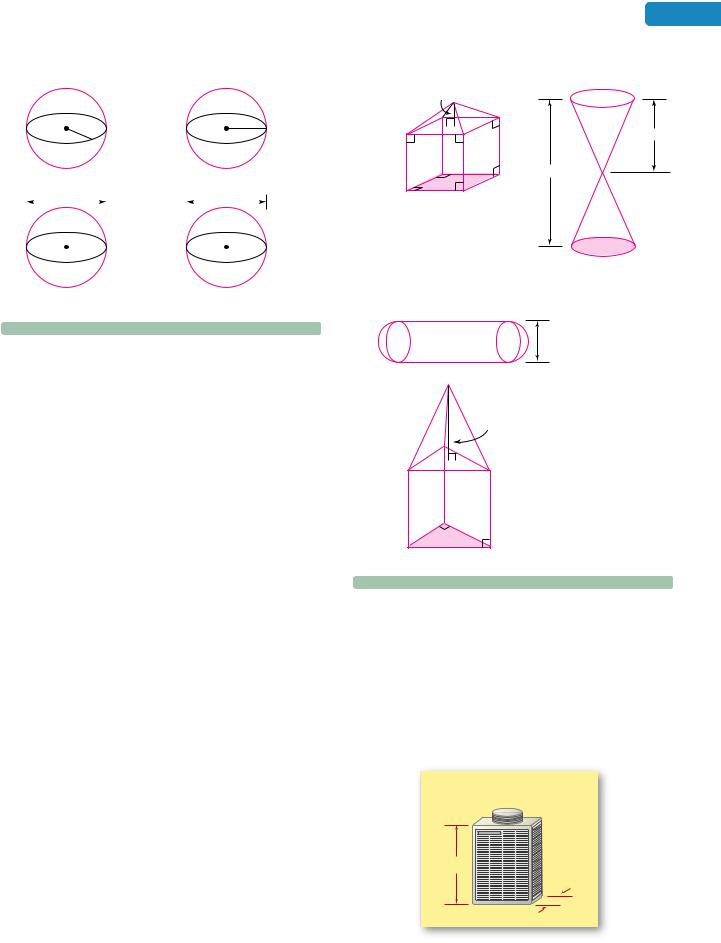
Find the volume of each sphere. Give the exact answer and an approximation to the nearest tenth. See Example 7.
53. 54.
6 in. |
9 ft |
|
55. |
|
|
4 cm |
|
|
56. |
|
10 in. |
|
|
|
||||||
|
|
|
|
|
|
|
|
|
 TRY IT YOURSELF
TRY IT YOURSELF
Find the volume of each figure. If an exact answer contains p, approximate to the nearest hundredth.
57.A hemisphere with a radius of 9 inches
(Hint: a hemisphere is an exact half of a sphere.)
58.A hemisphere with a diameter of 22 feet
(Hint: a hemisphere is an exact half of a sphere.)
59.A cylinder with a height of 12 meters and a circular base with a radius of 6 meters
60.A cylinder with a height of 4 meters and a circular base with a diameter of 18 meters
61.A rectangular solid with dimensions of 3 cm by 4 cm by 5 cm
62.A rectangular solid with dimensions of 5 m by 8 m by 10 m
63.A cone with a height of 12 centimeters and a circular base with a diameter of 10 centimeters
64.A cone with a height of 3 inches and a circular base with a radius of 4 inches
65.A pyramid with a square base 10 meters on each side and a height of 12 meters
66.A pyramid with a square base 6 inches on each side and a height of 4 inches
67.A prism whose base is a right triangle with legs 3 meters and 4 meters long and whose height is 8 meters
68.A prism whose base is a right triangle with legs 5 feet and 12 feet long and whose height is 25 feet
9.9 Volume |
809 |
Find the volume of each figure. Give the exact answer and, when needed, an approximation to the nearest hundredth.
69. |
3 cm |
70. |
10 in.
8 cm
20 in.
8 cm
8 cm
 8 in.
8 in. 

71.16 cm
6 cm
72.
|
|
8 in. |
6 in. |
4 |
|
. |
in. |
|
3 |
|
|
in |
|
|
|
5 in. |
|
 APPLICATIONS
APPLICATIONS
Solve each problem. If an exact answer contains p, approximate the answer to the nearest hundredth.
73.SWEETENERS A sugar cube is 12 inch on each edge. How much volume does it occupy?
74.VENTILATION A classroom is 40 feet long, 30 feet wide, and 9 feet high. Find the number of cubic feet of air in the room.
75.WATER HEATERS Complete the advertisement for the high-efficiency water heater shown below.
Over 200 gallons of hot water
from ? cubic feet of space...
27"
8"

 17"
17"

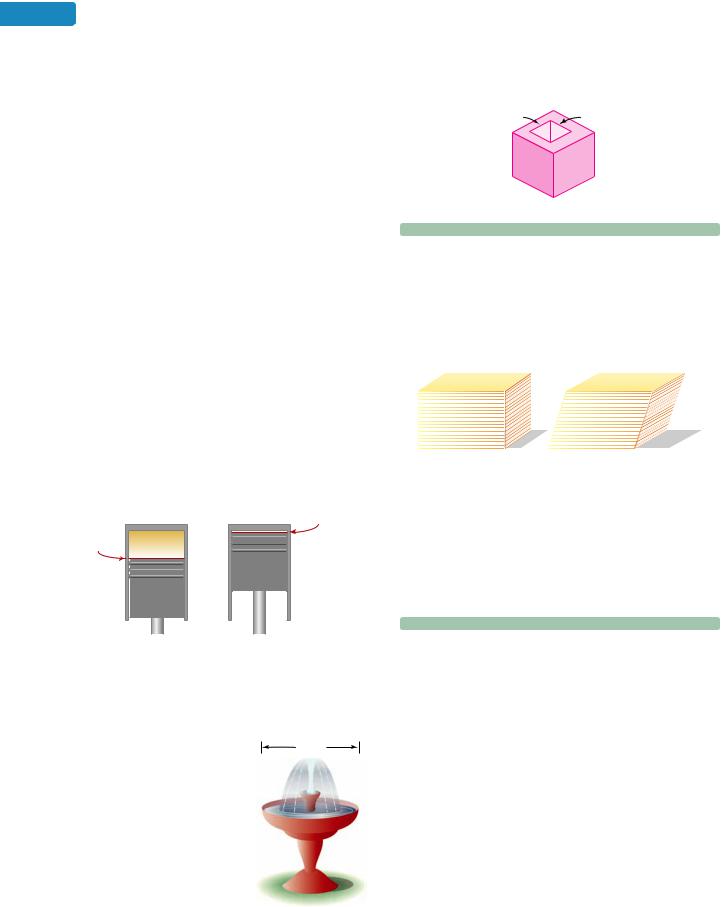
810Chapter 9 An Introduction to Geometry
76.REFRIGERATORS The largest refrigerator advertised in a JC Penny catalog has a capacity of 25.2 cubic feet. How many cubic inches is this?
77.TANKS A cylindrical oil tank has a diameter of
6 feet and a length of 7 feet. Find the volume of the tank.
78.DESSERTS A restaurant serves pudding in a conical dish that has a diameter of 3 inches. If the dish is 4 inches deep, how many cubic inches of pudding are in each dish?
79.HOT-AIR BALLOONS The lifting power of a spherical balloon depends on its volume. How many cubic feet of gas will a balloon hold if it is 40 feet in diameter?
80.CEREAL BOXES A box of cereal measures
3 inches by 8 inches by 10 inches. The manufacturer plans to market a smaller box that measures 212 by 7 by 8 inches. By how much will the volume be
reduced?
81.ENGINES The compression ratio of an engine is the volume in one cylinder with the piston at bottom- dead-center (B.D.C.), divided by the volume with the piston at top-dead-center (T.D.C.). From the data given in the following figure, what is the compression ratio of the engine? Use a colon to express your answer.
Volume before
compression: 30.4 in.3 |
B.D.C. |
Volume after
compression: 3.8 in.3 |
T.D.C. |
82. GEOGRAPHY Earth is not a perfect sphere but is slightly pear-shaped. To estimate its volume, we will assume that it is spherical, with a diameter of about 7,926 miles. What is its volume, to the nearest one billion cubic miles?
83. BIRDBATHS
30 in.
a.The bowl of the birdbath shown on the right is in the shape of a hemisphere (half of a sphere). Find its volume.
b.If 1 gallon of water occupies 231 cubic inches of space, how many gallons of water does the birdbath hold? Round to the nearest tenth.
84.CONCRETE BLOCKS Find the number of cubic inches of concrete used to make the hollow, cubeshaped, block shown below.
5 in. |
5 in. |
8 in.
8 in. |
8 in. |
 WRITING
WRITING
85.What is meant by the volume of a cube?
86.The stack of 3 5 index cards shown in figure (a) forms a right rectangular prism, with a certain volume. If the stack is pushed to lean to the right, as in figure (b), a new prism is formed. How will its volume compare to the volume of the right rectangular prism? Explain your answer.
(a) |
(b) |
87.Are the units used to measure area different from the units used to measure volume? Explain.
88.The dimensions (length, width, and height) of one rectangular solid are entirely different numbers from the dimensions of another rectangular solid. Would it be possible for the rectangular solids to have the same volume? Explain.
 REVIEW
REVIEW
89.Evaluate: 5(5 2)2 3
90.BUYING PENCILS Carlos bought 6 pencils at $0.60 each and a notebook for $1.25. He gave the clerk a $5 bill. How much change did he receive?
91.Solve: x 4
92.38 is what percent of 40?
93.Express the phrase “3 inches to 15 inches” as a ratio in simplest form.
94.Convert 40 ounces to pounds.
95.Convert 2.4 meters to millimeters.
96.State the Pythagorean equation.
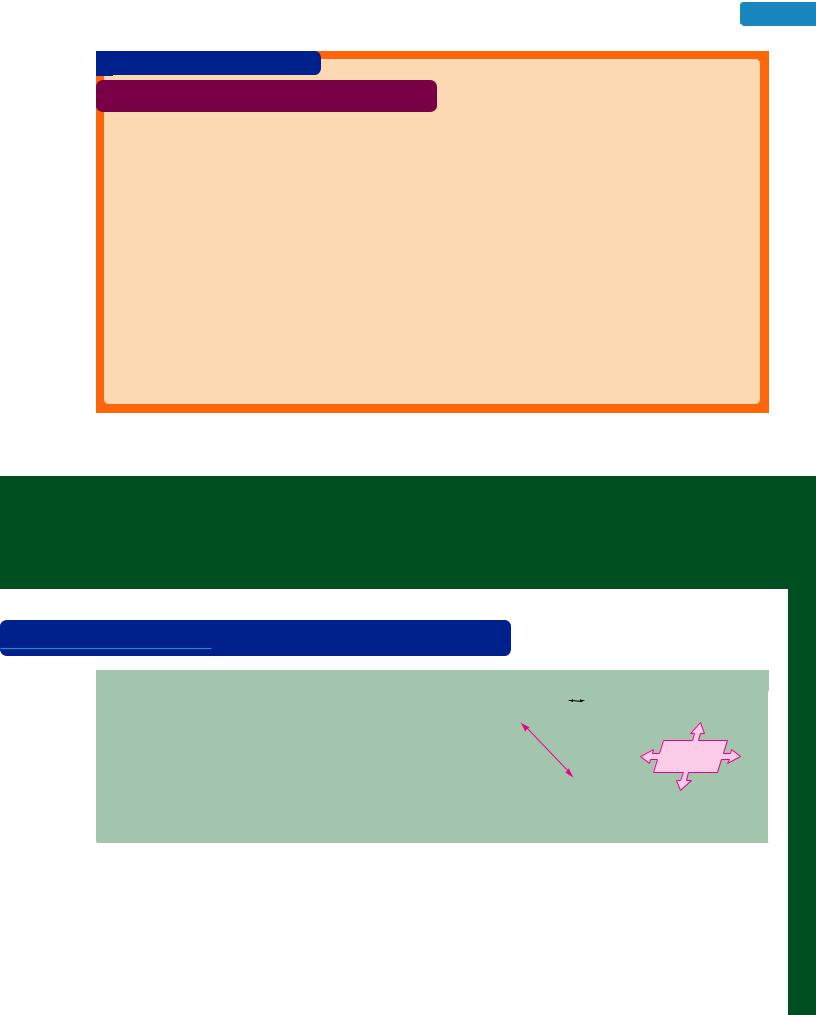
Chapter 9 Summary and Review |
811 |
STUDY SKILLS CHECKLIST
 Know the Vocabulary
Know the Vocabulary
A large amount of vocabulary has been introduced in Chapter 9. Before taking the test, put a checkmark in the box if you can define and draw an example of each of the given terms.
Point, line, plane
Line segment, midpoint
Ray, angle, vertex
Acute angle, obtuse angle, right angle, straight angle
Adjacent angles, vertical angles
Complementary angles, supplementary angles
Congruent segments, congruent angles
Parallel lines, perpendicular lines, a transversal
Alternate interior angles, interior angles, corresponding angles
Polygon, triangle, quadrilateral, pentagon, hexagon, octagon
Equilateral triangle, isosceles triangle, scalene triangle
Acute triangle, obtuse triangle
Right triangle, hypotenuse, legs
Congruent triangles, similar triangles
Parallelogram, rectangle, square, rhombus, trapezoid, isosceles trapezoid
Circle, arc, semicircle, radius, diameter
Rectangular solid, cube, sphere, prism, pyramid, cylinder, cone
C H A P T E R 9 SUMMARY AND REVIEW
 S E C T I O N 9.1 Basic Geometric Figures; Angles
S E C T I O N 9.1 Basic Geometric Figures; Angles
 DEFINITIONS AND CONCEPTS
DEFINITIONS AND CONCEPTS
The word geometry comes from the Greek words geo (meaning Earth) and metron (meaning measure).
Geometry is based on three undefined words: point, line, and plane.
EXAMPLES
Point |
Line BC |
 A
A
 B
B
 C
C
Points are |
We can name a |
labeled with |
line using any |
capital letters. |
two points on it. |
Plane EFG
 E
E  G
G
 F
F
Floors, walls, and table tops are all parts of planes.
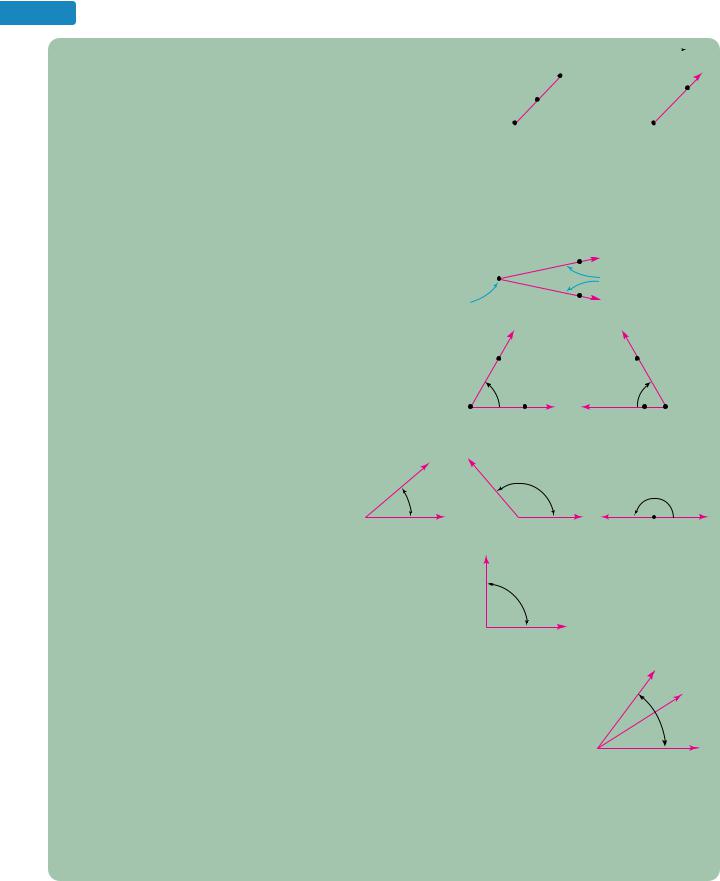
812 |
Chapter 9 An Introduction to Geometry |
|
|
|
|
|
|
|
|
|
|
|
|
|
|
|
|||||
|
|
|
|
|
|
|
|
|
|
|
|
|
|
|
|
|
|||||
|
|
|
|
|
|
|
|
|
|
|
|
|
|
|
|
|
|||||
|
|
A line segment is a part of a line with two endpoints. |
|
|
|
|
|
|
|
|
|
|
|||||||||
|
|
|
|
|
|
|
|
|
|
Line segment |
AB |
|
Ray CD |
||||||||
|
|
Every line segment has a midpoint, which divides the |
|
|
|
|
|
|
|
|
|
B endpoint |
|
|
|
||||||
|
|
segment into two parts of equal length. |
m( |
AM |
) m( |
MB |
) |
|
|
|
|
D |
|||||||||
|
|
|
|
|
|
|
|
|
|
|
|
|
|
|
M |
|
|
|
|
|
|
|
|
|
|
|
|
|
|
|
|
|
|
|
|
|
|
|
|
|
|
|
|
|
|
|
|
|
|
|
|
AM MB |
midpoint |
|
|
|
|||||||||
|
|
The notation m(AM) is read as “the measure of line |
|
|
|
||||||||||||||||
|
|
|
|
|
|
|
|
|
|
A |
|
|
|
C |
|||||||
|
|
|
|
|
|
|
|
|
|
|
|
|
|
|
|
|
|
||||
|
|
segment AM.” |
|
|
|
||||||||||||||||
|
|
|
|
|
|
|
|
|
|
endpoint |
|
|
|
endpoint |
|||||||
|
|
|
|
|
|
|
|
|
|
|
|
|
|
|
|
|
|
||||
When two line segments have the same measure, we say that they are congruent. Read the symbol as “is congruent to.”
A ray is a part of a line with one endpoint.
An angle is a figure formed by two rays (called sides) |
The angle below can be written as BAC, CAB, A, or 1. |
|||||||||
with a common endpoint. The common endpoint is |
|
|
|
|
B |
|
|
|
|
|
called the vertex of the angle. |
Angle |
|
|
|
|
|
|
|||
|
|
|
|
|
Sides of |
|||||
We read the symbol as “angle.” |
A |
1 |
|
|
|
|||||
|
|
|
the angle |
|||||||
|
Vertex of |
|
|
|
|
|
||||
|
|
|
C |
|
|
|
|
|||
|
the angle |
|
|
|
|
|
|
|||
|
|
|
|
|
|
|
|
|
|
|
When two angles have the same measure, we say that |
|
|
|
|
|
|
|
|
|
|
they are congruent. |
|
D |
|
|
|
S |
||||
A protractor is used to find the measure of an angle. |
Congruent |
|
|
|
|
|
|
|
||
angles |
|
|
|
|
|
|
|
|||
One unit of measurement of an angle is the degree. |
|
|
60° |
|
60° |
|
||||
The notation m( DEF) is read as “the measure of |
E |
|
F |
|
|
|
T |
|||
DEF.” |
|
|
|
|
|
|
V |
|||
Since m( DEF) m( STV), we say that DEF STV. |
||||||||||
|
||||||||||
|
|
|
|
|
|
|
|
|
|
|
An acute angle has a measure that is greater than 0° |
|
|
|
|
|
|
|
|
|
|
but less than 90°. An obtuse angle has a measure that |
|
|
|
|
|
180° |
|
|||
is greater than 90° but less than 180°.A straight angle |
|
|
130° |
|
|
|||||
40° |
|
|
|
|
|
|
||||
measures 180°. |
|
|
|
|
|
|
|
|
||
|
Acute angle |
Obtuse angle |
|
|
|
Straight angle |
||||
|
|
|
|
|
|
|
|
|
|
|
A right angle measures 90°. |
|
|
|
|
|
|
|
|
|
|
|
Right angle |
|
|
A |
|
|
symbol is |
|||
|
|
|
|
|||||||
|
|
|
often used to |
|||||||
|
|
|
90° |
label a right angle. |
||||||
|
|
|
|
|
|
|
|
|||
|
|
|
|
|
|
|
|
|
|
|
|
|
|
|
|
|
|
|
|
|
|
Two angles that have the same vertex and are side- |
Two angles with degree measures of x |
|
|
|
|
|||||
|
|
Adjacent angles |
||||||||
by-side are called adjacent angles. |
and 21° are adjacent angles, as shown |
|
|
|
|
|||||
|
here. Use the information in the figure to |
|
|
|
|
|||||
|
find x. |
|
|
|
|
|
21° |
|
||
|
|
|
|
|
|
|
|
|||
|
|
|
|
|
|
|
32° |
|
||
|
|
|
|
|
|
|
|
x |
|
|
|
|
|
|
|||||||
We can use the algebra concepts of variable and |
The sum of the measures of the two adjacent angles is 32°: |
|||||||||
equation to solve many types of geometry problems. |
x 21° 32° |
The word sum indicates addition. |
||||||||
|
||||||||||
|
x 21° 21° 32° 21° |
Subtract 21° from both sides. |
||||||||
|
x 11° |
Do the subtraction. |
||||||||
|
Thus, x is 11°. |
|
|
|
|
|
|
|
||
|
|
|
|
|
|
|
|
|
|
|
|
|
|
|
|
|
|
|
|
|
|
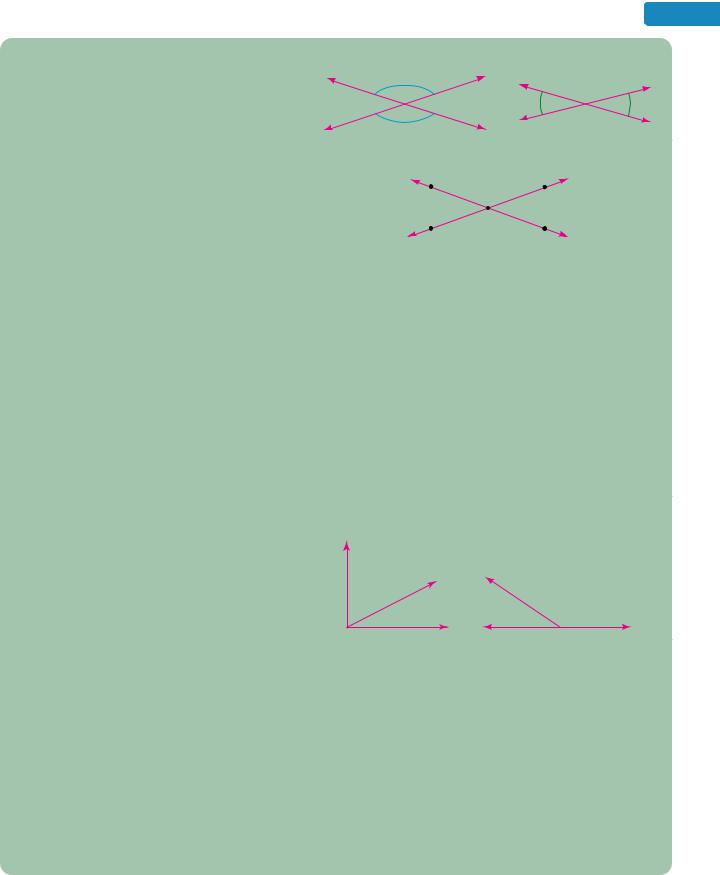
Chapter 9 Summary and Review |
813 |
|
|
|
|
|
|
|
When two lines intersect, pairs of nonadjacent angles |
Vertical angles |
are called vertical angles. |
|
Vertical angles are congruent (have the same Refer to the figure below. Find x and m( XYZ). |
|||
measure). |
|
|
Z |
X |
3x + |
20° |
|
|
|
||
|
Y |
|
|
R |
2x + 70° |
T |
|
|
|
||
Since the angles are vertical angles, they have equal measures. |
|||
3x 20° 2x 70° |
Set the expressions equal. |
||
3x 20° 2x 2x 70° 2x Eliminate 2x from the right |
|||
|
|
|
side. |
x 20° 70° |
|
Combine like terms. |
|
x 50° |
|
Subtract 20° from both sides. |
|
Thus, x is 50°. To find m( XYZ), evaluate the expression 3x 20° for x 50°.
|
3x 20° 3(50°) 20° |
Substitute 50° for x. |
|
150° 20° |
Do the multiplication. |
|
170° |
Do the addition. |
|
Thus, m( XYZ) 170°. |
|
If the sum of two angles is 90°, the angles are |
Complementary angles |
Supplementary angles |
complementary. |
63° 27° 90° |
146° 34° 180° |
|
||
If the sum of two angles is 180°, the angles are |
|
|
supplementary. |
|
|
|
63° |
146° |
|
|
|
|
27° |
34° |
We can use algebra to find the complement of an |
Find the complement of an 11° angle. |
angle. |
Let x the measure of the complement (in degrees). |
|
|
|
x 11° 90° The sum of the angles’ measures must be 90°. |
|
x 79° To isolate x, subtract 11° from both sides. |
|
The complement of an 11° angle has measure 79°. |
|
|
We can use algebra to find the supplement of an |
Find the supplement of a 68° angle. |
angle. |
Let x the measure of the supplement (in degrees). |
|
|
|
x 68° 180° The sum of the angles’ measures must be 180°. |
|
x 112° To isolate x, subtract 68° from both sides. |
|
The supplement of a 68° angle has measure 112°. |
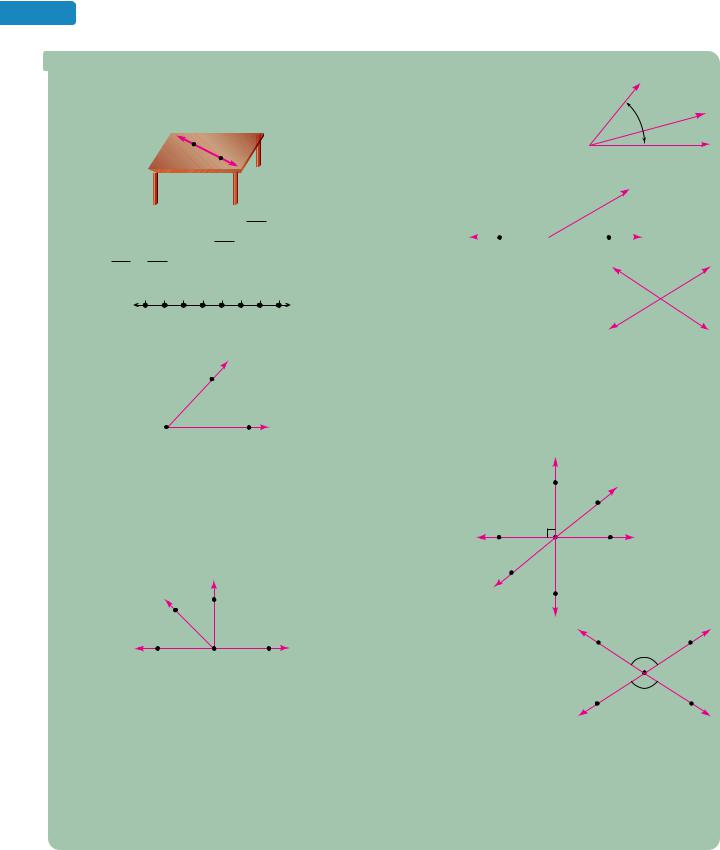
814 |
Chapter 9 An Introduction to Geometry |
 REVIEW EXERCISES
REVIEW EXERCISES
1.In the illustration, give the name of a point, a line, and a plane.
G H
C
D
I
2.a. In the figure below, find m(AG).
b.Find the midpoint of BH.
c.Is AC GE?
A B C D E F G H
1 |
2 |
3 |
4 |
5 |
6 |
7 |
8 |
3. Give four ways to name the angle shown below.
A
1
B
C
4.a. Is the angle shown above acute or obtuse?
b.What is the vertex of the angle?
c.What rays form the sides of the angle?
d.Use a protractor to find the measure of the angle.
5.Identify each acute angle, right angle, obtuse angle, and straight angle in the figure below.
E |
|
D |
|
|
|
|
2 |
|
1 |
|
90° |
A |
B |
C |
6.In the figure above, is ABD CBD?
¡¡
7.In the figure above, are AC and AB the same ray?
8.The measures of several angles are given below. Identify each angle as an acute angle, a right angle, an obtuse angle, or a straight angle.
a.m( A) 150°
b.m( B) 90°
c.m( C) 180°
d.m( D) 25°
9. The two angles shown here are
adjacent angles. Find x.
50°
35°
x
10. Line AB is shown in the figure below. Find y.
y |
30° |
|
|
A |
B |
11. Refer to the figure on the right.
a. Find m( 1). |
2 |
|
1 |
||
65° |
b.Find m( 2).
12.Refer to the figure below.
a.What is m( ABG)?
b.What is m( FBE)?
c.What is m( CBD)?
d.What is m( FBG)?
e.Are CBD and DBE complementary angles?
|
C |
|
|
|
|
|
D |
|
|
|
39° |
|
|
|
A |
B |
E |
|
|
G |
|
|
|
|
|
F |
|
|
|
13. Refer to the figure. |
E |
5x + 25° |
G |
|
a. Find x. |
|
F |
|
|
|
|
|
||
b. What is m( HFI)? |
I |
6x + 5° |
H |
|
c. What is m( GFH)? |
||||
|
|
|
14.Find the complement of a 71° angle.
15.Find the supplement of a 143° angle.
16.Are angles measuring 30°, 60°, and 90° supplementary?
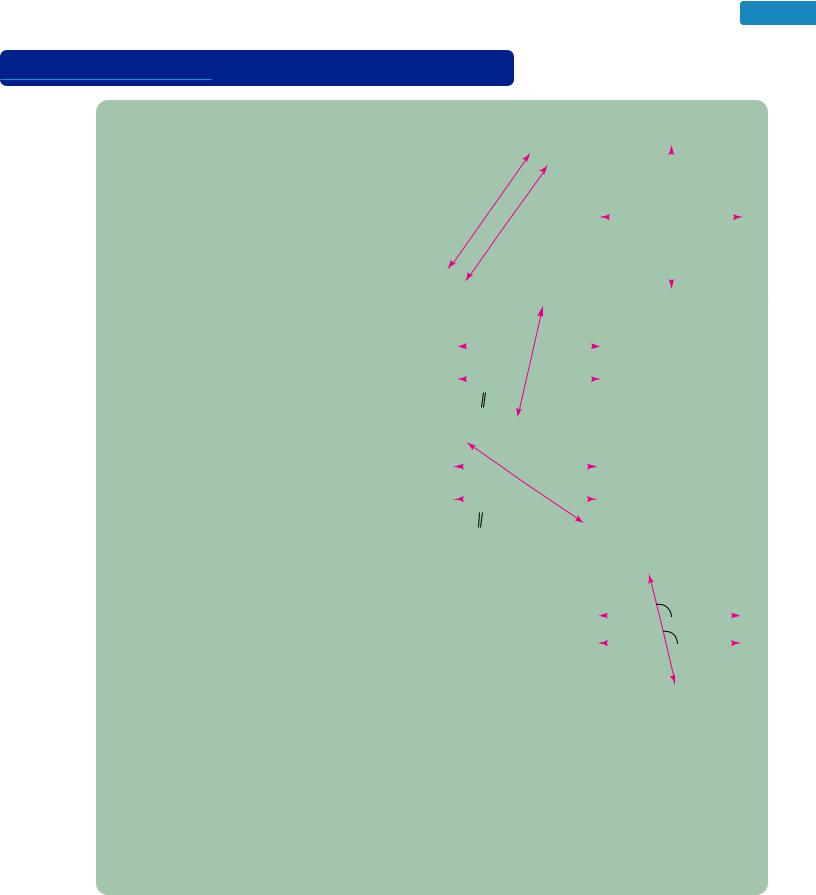
Chapter 9 Summary and Review |
815 |
 S E C T I O N 9.2 Parallel and Perpendicular Lines
S E C T I O N 9.2 Parallel and Perpendicular Lines
|
DEFINITIONS AND CONCEPTS |
EXAMPLES |
|
|
|
|
|
If two lines lie in the same plane, they are called coplanar. |
Parallel lines |
Perpendicular lines |
|||
|
Parallel lines are coplanar lines that do not intersect. |
|
|
|
|
|
|
|
|
|
|
|
|
|
We read the symbol as “is parallel to.” |
|
|
|
|
|
|
Perpendicular lines are lines that intersect and form right |
|
|
|
|
|
|
angles. |
|
|
|
|
|
|
|
|
|
|
|
|
|
We read the symbol as “is perpendicular to.” |
|
|
|
|
|
|
|
|
|
|
|
|
A line that intersects two coplanar lines in two distinct |
|
|
|
|
|
Transversal |
|
|
Corresponding angles |
|||||||
(different) points is called a transversal. |
|
|
|
|
7 |
8 |
|
|
|
|
|
|
|
• 1 5 |
||
When a transversal intersects two coplanar lines, four |
|
|
|
|
|
|
|
|
|
l1 |
|
• 2 6 |
||||
|
|
|
|
5 |
6 |
|
|
|
|
|
|
• 3 7 |
||||
pairs of corresponding angles are formed. |
|
|
|
|
|
|
|
|
|
|
|
|||||
|
|
|
3 |
4 |
|
|
|
|
|
|
|
• 4 8 |
||||
|
|
|
|
|
|
|
|
|
l2 |
|
|
|
|
|||
If two parallel lines are cut by a transversal, corresponding |
|
|
|
1 |
2 |
|
|
|
|
|
|
|
|
|
||
|
|
|
|
|
|
|
|
|
|
|
|
|
||||
angles are congruent (have equal measures). |
|
|
l1 |
l2 |
|
|
|
|
|
|
|
|
|
|
|
|
|
|
|
|
|
|
|
|
|
|
|
|
|
|
|
||
When a transversal intersects two coplanar lines, two |
|
|
|
Transversal |
|
|
|
|
|
|
|
Alternate interior angles |
||||
pairs of interior angles and two pairs of alternate interior |
|
|
|
|
|
|
|
|
|
|
|
l1 |
• 1 4 |
|||
angles are formed. |
|
|
|
|
|
|
|
|
|
|
|
• 2 3 |
||||
|
|
|
3 |
4 |
|
|
|
|
|
|||||||
|
|
|
|
|
|
|
|
|
|
|||||||
If two parallel lines are cut by a transversal, alternate |
|
|
|
|
1 |
2 |
|
|
|
|
|
l2 |
Interior angles |
|||
interior angles are congruent (have equal measures). |
|
|
l1 |
l2 |
|
|
|
|
|
|
|
m( 1) |
m( 3) = 180° |
|||
|
|
|
|
|
|
|
|
|
|
|||||||
If two parallel lines are cut by a transversal, interior angles |
|
|
|
|
|
|
|
|
|
|
m( 2) m( 4) = 180° |
|||||
|
|
|
|
|
|
|
|
|
|
|
|
|
|
|
|
|
on the same side of the transversal are supplementary. |
|
|
|
|
|
|
|
|
|
|
|
|
|
|
|
|
|
|
|
|
|
|
|
|
|
|
|
||||||
We can use algebra to find the unknown measures of |
In the figure, l1 l2. Find x |
|
|
|
|
|
|
|
||||||||
|
|
|
|
|
|
|
||||||||||
corresponding angles. |
and the measure of each |
|
|
|
|
5x + 15° |
|
|||||||||
|
angle that is labeled. |
|
|
|
|
|
||||||||||
|
|
|
|
|
|
l1 |
|
|||||||||
|
Since the lines are parallel, |
|
|
|
|
|
|
|||||||||
|
|
|
|
|
4x + 35° |
|
||||||||||
|
and the angles are |
|
|
|
|
|
|
|
|
|
l2 |
|
||||
|
|
|
|
|
|
|
|
|
|
|
||||||
|
corresponding angles, the |
|
|
|
|
|
|
|
||||||||
|
angles are congruent. |
|
|
|
|
|
|
|
||||||||
|
5x 15° 4x 35° The angle measures are equal. |
|||||||||||||||
|
|
x 15° 35° Subtract 4x from both sides. |
||||||||||||||
|
|
|
|
x 20° To isolate x, subtract 15° from both sides. |
||||||||||||
|
Thus, x is 20°. To find the measures of the angles labeled in |
|||||||||||||||
|
the figure, we evaluate each expression for x 20°. |
|||||||||||||||
|
5x 15° 5(20°) 15° |
|
|
4x 35° 4(20°) 35° |
||||||||||||
|
|
|||||||||||||||
|
|
|
|
100° 15° |
|
|
|
|
|
|
80° 35° |
|
|
|||
|
|
|
|
115° |
|
|
|
|
|
|
|
115° |
|
|
||
|
The measure of each angle is 115°. |
|
|
|
|
|||||||||||
|
|
|
|
|
|
|
|
|
|
|
|
|
|
|
|
|
|
|
|
|
|
|
|
|
|
|
|
|
|
|
|
|
|
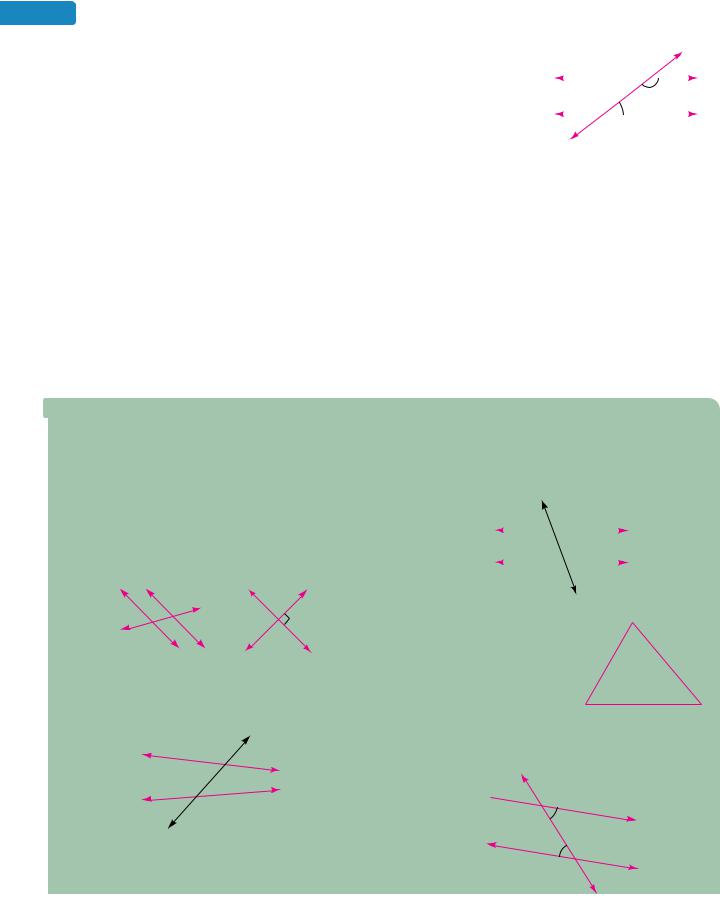
816 |
Chapter 9 An Introduction to Geometry |
|
|
|
|
|
|
|
|
|
|
|
|
|
|
|
|
|
|
|
|
|
|
|
|
|
|
|
|
|
|
|
|
|
We can use algebra to find the unknown |
In the figure, l1 l2. Find x and the |
|
|
|
|
|
||
|
|
measures of interior angles. |
measure of each angle that is labeled. |
|
|
|
l1 |
|
||
|
|
|
|
|
|
|
|
|
|
|
|
|
|
Since the angles are interior angles |
|
|
4x + 17° |
|
|||
|
|
|
on the same side of the transversal, |
|
|
x – 12° |
|
|||
|
|
|
they are supplementary. |
|
|
|
|
|
l2 |
|
|
|
|
|
|
|
|
|
|
||
|
|
|
|
|
|
|
|
|
|
|
|
|
|
4x 17° x 12° 180° |
|
|
|
|
|
|
|
|
|
|
|
The sum of the measures of two |
||||||
|
|
|
|
|
supplementary angles is 180°. |
|||||
|
|
|
5x 5° 180° |
|
Combine like terms. |
|
|
|
||
|
|
|
5x 175° |
|
Subtract 5° from both sides. |
|||||
|
|
|
x 35° |
|
Divide both sides by 5. |
|||||
|
|
|
Thus, x is 35°. To find the measures of the angles in the figure, we |
|||||||
|
|
|
evaluate the expressions for x 35°. |
|
|
|
||||
|
|
|
4x 17° 4(35°) 17° |
|
x 12° 35° 12° |
|||||
|
|
|
|
|||||||
|
|
|
140° 17° |
|
23° |
|
|
|
||
|
|
|
157° |
|
|
|
|
|
|
|
|
|
|
The measures of the angles labeled in the figure are 157° and 23°. |
|||||||
|
|
|
|
|
|
|
|
|
|
|
 REVIEW EXERCISES
REVIEW EXERCISES
17.a. Lines l1 and l2 shown in figure (a) below do not intersect and are coplanar. What word describes the lines?
b.In figure (a), line l3 intersects lines l1 and l2 in two distinct (different) points. What is the name given to line l3?
c.What word describes the two lines shown in figure (b) below?
l1 l2
l3
(a) |
(b) |
18.Identify all pairs of alternate interior angles shown in the figure below.
8 7
5 6
4 3
1 2
19.Refer to the figure in Problem 18. Identify all pairs of corresponding angles.
20.Refer to the figure in Problem 18. Identify all pairs of vertical angles.
21.In the figure below, l1 l2. Find the measure of each angle.
1 |
2 |
|
|
|
|
|
|
|
|
|||||
|
|
|
|
l1 |
|
|
|
|
|
|
|
|
|
|
|
|
|
|
|
|
3 |
|
|
|
|
|
|
|
|
110° |
|
|
|
|
|
|
|
|
||||||
5 |
|
4 |
|
|
|
|
|
|
|
|||||
|
|
|
|
l2 |
|
|
|
|
|
|
|
|
|
|
|
|
|
|
|
6 |
7 |
|
|
|
|
|
|
||
|
|
|
|
|
|
|
|
|
|
|
|
|||
|
|
|
|
|
|
|
|
|
|
|
|
|
|
|
|
|
|
|
|
|
|
|
|
|
|
E |
|
|
|
22. In the figure on the right, |
|
|
|
|
|
|
|
|
||||||
|
|
|
|
. Find the measure |
of |
70° |
|
|
|
|||||
|
DC |
AB |
|
|
|
|||||||||
|
each angle that is labeled. |
|
D |
|
60° |
4 |
|
C |
||||||
|
|
|
|
|
|
|
|
|
|
|
|
3 |
||
|
|
|
|
|
|
|
|
2 |
|
|
|
|
||
|
|
|
|
|
|
|
|
1 |
|
|
|
|
50° |
|
23. In the figure below, l1 l2. |
|
A |
|
|
|
|
B |
|||||||
|
|
|
|
|
|
|
|
|||||||
a.Find x.
b.Find the measure of each angle that is labeled.
l1 
2x − 30°
l2 |
x + 10° |

24.In the figure below, l1 l2.
a.Find x.
b.Find the measure of each angle that is labeled.
 l1
l1
3x + 50°
4x − 10° |
l2 |
25.In the figure below, AB DC.
a.Find x.
b.Find the measure of each angle that is labeled.
A |
|
B |
|
7x − 46° |
|||
|
|
||
D |
2x + 9° |
C |
|
|
Chapter 9 Summary and Review |
817 |
26.In the figure below, EF HI.
a.Find x.
b.Find the measure of each angle that is labeled.
H
E |
G |
5x − 33° |
|
3x + 13° |
I |
|
|
|
F |
|
|
 S E C T I O N 9.3 Triangles
S E C T I O N 9.3 Triangles
 DEFINITIONS AND CONCEPTS
DEFINITIONS AND CONCEPTS
A polygon is a closed geometric figure with at least three line segments for its sides. The points at which the sides intersect are called vertices. A regular polygon has sides that are all the same length and angles that are all the same measure.
The number of vertices of a polygon is equal to the number of sides it has.
Classifying Polygons
Number |
Name of |
Number |
Name of |
of sides |
polygon |
of sides |
polygon |
|
|
|
|
3 |
triangle |
8 |
octagon |
4 |
quadrilateral |
9 |
nonagon |
5 |
pentagon |
10 |
decagon |
6 |
hexagon |
12 |
dodecagon |
|
|
|
|
A triangle is a polygon with three sides (and three vertices).
Triangles can be classified according to the lengths of their sides.
Tick marks indicate sides that are of equal length.
EXAMPLES
Polygon |
|
Regular polygon |
|
vertex |
|
|
|
side |
side |
|
|
vertex |
|
vertex |
|
|
|
|
|
side |
|
side |
|
|
|
|
|
vertex |
side |
vertex |
|
|
|
||
Quadrilateral |
|
Hexagon |
Octagon |
(4 sides) |
|
(6 sides) |
(8 sides) |
|
|
|
|
|
|
|
|
Equilateral triangle |
Isosceles triangle |
Scalene triangle |
(all sides of |
(at least two sides of |
(no sides of |
equal length) |
equal length) |
equal length) |
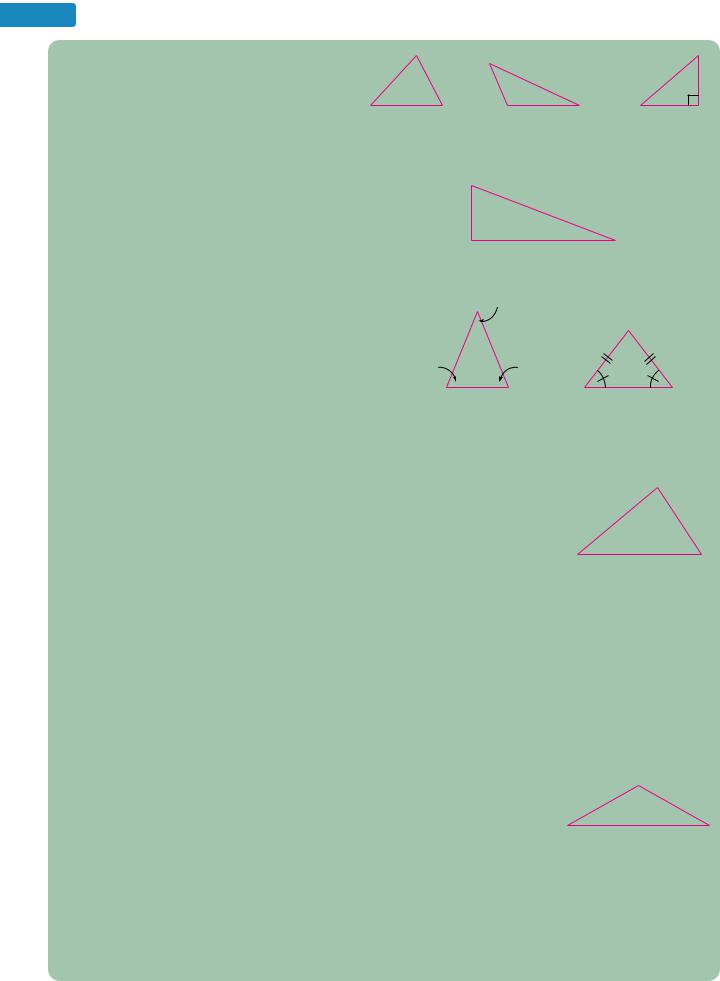
818 |
Chapter 9 An Introduction to Geometry |
|
|
|
|
|
|
|
Triangles can be classified by their angles.
Acute triangle |
Obtuse triangle |
Right triangle |
(has three acute angles) |
(has an obtuse angle) |
(has one right angle) |
The longest side of a right triangle is called the |
|
|
Right triangle |
hypotenuse, and the other two sides are called legs. |
|
|
Hypotenuse |
The hypotenuse of a right triangle is always opposite |
|
|
|
the 90° (right) angle. The legs of a right triangle are |
|
|
(longest side) |
Leg |
|||
adjacent to (next to) the right angle. |
|
|
Leg |
|
|
||
|
|
|
|
|
|
|
|
In an isosceles triangle, the angles opposite the sides |
|
Isosceles triangles |
|
|
|||||
of equal length are called base angles. The third |
Vertex angle |
|
|
|
|
|
|||
angle is called the vertex angle. The third side is |
|
|
|
|
|
||||
|
|
|
|
|
|
|
|
|
|
called the base. |
|
|
|
|
|
|
|
|
|
Isosceles Triangle Theorem: If two sides of a |
|
|
|
|
|
|
|
|
|
triangle are congruent, then the angles opposite |
Base angle |
Base angle |
|
|
|||||
those sides are congruent. |
|
|
|||||||
|
|
|
|
|
|
|
|
|
|
Converse of the Isosceles Triangle Theorem: If two |
Base |
|
|
|
|
|
|
|
|
angles of a triangle are congruent, then the sides |
|
|
|
|
|
|
|
|
|
opposite the angles have the same length, and the |
|
|
|
|
|
|
|
|
|
triangle is isosceles. |
|
|
|
|
|
|
|
|
|
|
|
|
|
|
|
|
|||
The sum of the measures of the angles of any |
Find the measure of each angle of ABC. |
B |
|||||||
triangle is 180°. |
|
|
|
|
|
|
|
|
|
We can use algebra to find unknown angle |
The sum of the angle measures of any |
|
3x – 25° |
||||||
measures of a triangle. |
triangle is 180°: |
|
|
|
|
|
|
|
|
|
x 3x 25° x 5° 180° |
|
x – 5° |
x |
|||||
|
|
C |
A |
||||||
|
5x 30° 180° |
Combine like terms. |
|
|
|||||
|
|
5x 210° |
Add 30° to both sides. |
||||||
|
|
x 42° |
|
Divide both sides by 5. |
|||||
|
To find the measures of B and C, we evaluate the expressions |
||||||||
|
3x 25° and x 5° for x 42°. |
|
|
|
|
|
|||
|
3x 25° 3(42°) 25° |
|
|
x 5° 42° 5° |
|
|
|||
|
|
|
|
||||||
|
126° 25° |
|
|
|
37° |
|
|
||
|
101° |
|
|
|
|
|
|
|
|
|
Thus, m( A) 42°, m( B) 101°, and m( C) 37°. |
||||||||
|
|
|
|
|
|
||||
We can use algebra to find unknown angle measures |
If the vertex angle of an isosceles triangle measures 26°, what is the |
||||||||
of an isosceles triangle. |
measure of each base angle? |
|
|
|
|
|
|||
|
|
26° |
|
|
|||||
|
If we let x represent the measure of |
|
|
|
|||||
|
|
x |
x |
|
|||||
|
one base angle, the measure of the |
|
|
||||||
|
|
|
|
|
|||||
|
|
|
|
|
|||||
|
other base angle is also x. (See the figure.) Since the sum of the |
||||||||
|
measures of the angles of any triangle is 180°, we have |
|
|
||||||
|
x x 26° 180° |
|
|
|
|
|
|
|
|
|
2x 26° 180° On the left side, combine like terms. |
||||||||
|
2x 154° |
To isolate 2x, subtract 26° from both sides. |
|||||||
|
x 77° |
To isolate x, divide both sides by 2. |
|||||||
|
The measure of each base angle is 77°. |
|
|
|
|
||||

 REVIEW EXERCISES
REVIEW EXERCISES
27.For each of the following polygons, give the number of sides it has, tell its name, and then give the number of vertices that it has.
a. b.
c. d.
e. f.
28.Classify each of the following triangles as an equilateral triangle, an isosceles triangle, a scalene triangle, or a right triangle. Some figures may be correctly classified in more than one way.
a. |
b. |
|
|
6 cm |
7 cm |
8 in. |
8 in. |
|
|
|
9 cm |
c. |
d. |
|
5 m |
5 m |
44° |
5 m |
|
44° |
29.Classify each of the following triangles as an acute, an obtuse, or a right triangle.
a. b.
90°
70° 20°
50° 50°
c. 160°
15°  5°
5°
d.
60°
50°
Chapter 9 Summary and Review |
819 |
30. Refer to the triangle shown here. |
|
Y |
||
a. |
What is the measure of X? |
|
|
|
b. |
What type of triangle is it? |
|
|
|
c. |
What two line segments |
Z |
|
X |
|
||||
|
|
|
||
are the legs?
d.What line segment is the hypotenuse?
e.Which side of the triangle is the longest?
f.Which side is opposite X?
In each triangle shown below, find x.
31. 32. x
70°
70° 20°
60° x
33.In ABC, m( B) 32° and m( C) 77°. Find m( A).
34.For the triangle shown below, find x. Then determine the measure of each angle of the triangle.
2x
x + 10°
5x + 26°
35.One base angle of an isosceles triangle measures 65°. Find the measure of the vertex angle.
36.The measure of the vertex angle of an isosceles triangle is 68°. Find the measure of each base angle.
37. Find the measure of C |
A |
|
of the triangle shown |
56.5° |
|
here. |
|
C |
|
B |
|
38. Refer to the figure shown |
D |
E |
here. Find m( C). |
|
|
|
|
|
|
81° |
19° |
|
|
|
|
50° |
|
|
47° |
|
A |
B |
C |
70°
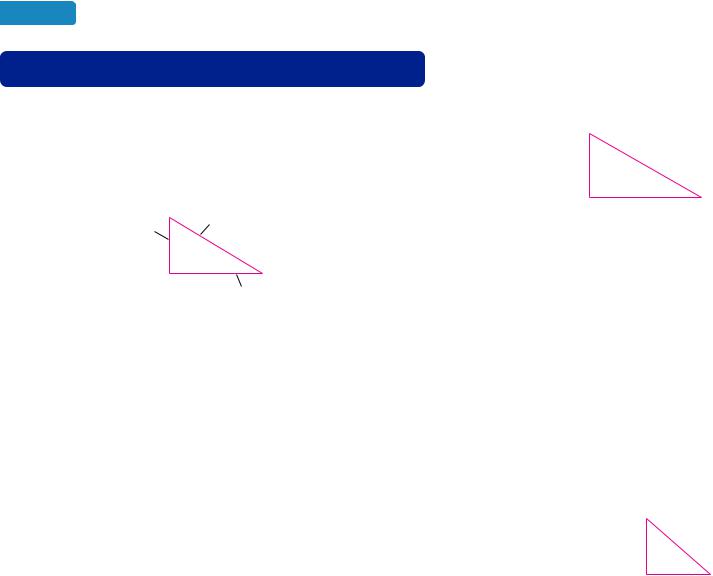
820 Chapter 9 An Introduction to Geometry
|
S E C T I O N 9.4 |
The Pythagorean Theorem |
|
|
|
|
|
|
|
|
|
|
|
|
|
|
|
|
|
|
|
|
||||
|
|
|
|
|
|
|
|
|
|
|
|
|
|
|
|
|
|
|
|
|
|
|
|
|
|
|
|
|
|
|
|
|
|
|
|
|
|
|
|
|
|
|
|
|
|
|
|
|
|
|
|
|
|
|
DEFINITIONS AND CONCEPTS |
EXAMPLES |
|
|
|
|
|
|
|
|
|
|
|
|
|
|
|
|
|
|
|
|
||||
|
Pythagorean theorem |
|
Find the length of the hypotenuse |
|
|
|
|
|
|
|
|
|
|
|
|
|
||||||||||
|
|
|
|
|
|
|
|
|
|
|
|
|
|
|
||||||||||||
|
If a and b are the lengths of the legs of a right triangle |
of the right triangle shown here. |
|
|
|
|
|
|
|
|
|
|
|
|
|
|||||||||||
|
and c is the length of the hypotenuse, then |
We will let a 6 and b 8, and |
|
|
6 in. |
|
|
|
|
|
|
|||||||||||||||
|
|
|
|
|
|
|
|
|
|
|
|
|
|
|
|
|
||||||||||
|
a2 b2 c2 |
|
substitute into the Pythagorean |
|
|
|
|
|
|
|
|
|
|
|
|
|
||||||||||
|
|
|
|
|
|
|
|
|
|
|
|
|
|
|
||||||||||||
|
|
|
Hypotenuse |
equation to find c. |
|
|
|
|
|
|
|
|
|
|
|
|
|
8 in. |
|
|
||||||
|
Leg |
a2 b2 c2 |
|
This is the Pythagorean equation. |
|
|
|
|
|
|
||||||||||||||||
|
c |
|
|
|
|
|
|
|
||||||||||||||||||
|
a |
62 82 c2 |
|
Substitute 6 for a and 8 for b. |
|
|
|
|
|
|
||||||||||||||||
|
|
|
|
|
|
|
|
|
||||||||||||||||||
|
|
|
b |
36 64 c2 |
|
Evaluate the exponential expressions. |
||||||||||||||||||||
|
|
|
|
|||||||||||||||||||||||
|
|
|
|
|||||||||||||||||||||||
|
|
|
100 c2 |
|
Do the addition. |
|
|
|
|
|
|
|||||||||||||||
|
|
|
Leg |
|
|
|
|
|
|
|
||||||||||||||||
|
a2 b2 c2 is called the Pythagorean equation. |
c2 100 |
Reverse the sides of the equation so that c2 is |
|||||||||||||||||||||||
|
|
|
|
|
on the left. |
|
|
|
|
|
|
|
|
|
|
|
|
|
|
|||||||
|
|
|
|
|
|
|
|
|
|
|
|
|
|
|
|
|
|
|
|
|
|
|||||
|
|
|
|
To find c, we must find a number that, when squared, is 100.There |
||||||||||||||||||||||
|
|
|
|
are two such numbers, one positive and one negative; they are the |
||||||||||||||||||||||
|
|
|
|
square roots of 100. Since c represents the length of a side of a |
||||||||||||||||||||||
|
|
|
|
triangle, c cannot be negative. For this reason, we need only find |
||||||||||||||||||||||
|
|
|
|
the positive square root of 100 to get c. |
|
|
|
|
|
|
||||||||||||||||
|
|
|
|
c 1 |
|
|
The symbol 1 |
|
|
is used to indicate the postive |
||||||||||||||||
|
|
|
|
100 |
|
|
||||||||||||||||||||
|
|
|
|
|
|
|
square root of a number. |
|
|
|
|
|
|
|||||||||||||
|
|
|
|
c 10 |
Because 102 100. |
|
|
|
|
|
|
|||||||||||||||
|
|
|
|
The length of the hypotenuse of the triangle is 10 in. |
|
|
|
|
|
|
||||||||||||||||
|
When we use the Pythagorean theorem to find the |
The lengths of two sides of a right triangle are |
|
|
|
|
|
|
|
|||||||||||||||||
|
|
|
|
|
|
|
|
|||||||||||||||||||
|
length of a side of a right triangle, the solution is |
shown here. Find the missing side length. |
9 ft |
|
|
|
11 ft |
|
||||||||||||||||||
|
sometimes the square root of a number that is not a |
We may substitute 9 for either a or b, but 11 |
|
|
|
|
|
|
||||||||||||||||||
|
|
|
|
|
|
|
|
|||||||||||||||||||
|
perfect square. In that case, we can use a calculator to |
|
|
|
|
|
|
|
||||||||||||||||||
|
must be substituted for the length c of the |
|
|
|
|
|
|
|
||||||||||||||||||
|
approximate the square root. |
|
|
|
|
|
|
|
||||||||||||||||||
|
hypotenuse. If we substitute 9 for a, we can find the unknown side |
|||||||||||||||||||||||||
|
|
|
|
|||||||||||||||||||||||
|
|
|
|
length b as follows. |
|
|
|
|
|
|
|
|
|
|
|
|
|
|
|
|
|
|
|
|||
|
|
|
|
a2 b2 c2 |
This is the Pythagorean equation. |
|||||||||||||||||||||
|
|
|
|
92 b2 112 |
Substitute 9 for a and 11 for c. |
|||||||||||||||||||||
|
|
|
|
81 b2 121 |
Evaluate each exponential expression. |
|||||||||||||||||||||
|
|
|
|
81 b2 81 121 81 |
To isolate b2 on the left side, |
|||||||||||||||||||||
|
|
|
|
|
|
|
|
|
|
|
|
|
subtract 81 from both sides. |
|||||||||||||
|
|
|
|
|
|
b2 40 |
|
|
|
|
|
|
|
|
|
|
|
|
|
|
|
|
|
|||
|
|
|
|
We must find a number that, when squared, is 40. Since b |
||||||||||||||||||||||
|
|
|
|
represents the length of a side of a triangle, we consider only the |
||||||||||||||||||||||
|
|
|
|
positive square root. |
1 |
|
|
|
|
|
|
|
|
|
|
|
|
|
|
|
|
|
|
|||
|
|
|
|
|
|
b |
|
|
|
|
This is the exact length. |
|||||||||||||||
|
|
|
|
|
|
40 |
|
|
|
|||||||||||||||||
|
|
|
|
The missing side length is exactly |
1 |
|
feet long. Since 40 is not a |
|||||||||||||||||||
|
|
|
|
40 |
||||||||||||||||||||||
|
|
|
|
perfect square, we use a calculator to approximate |
1 |
|
To the |
|||||||||||||||||||
|
|
|
|
40. |
||||||||||||||||||||||
|
|
|
|
nearest hundredth, the missing side length is 6.32 ft. |
|
|
|
|
|
|
||||||||||||||||
|
|
|
|
|
|
|
|
|
|
|
|
|
|
|
|
|
|
|
|
|
|
|
|
|
|
|
|
|
|
|
|
|
|
|
|
|
|
|
|
|
|
|
|
|
|
|
|
|
|
|
|
|
|

Chapter 9 Summary and Review |
821 |
|
|
|
|
|
|
|
The converse of the Pythagorean theorem:
If a triangle has sides of lengths a, b, and c, such that a2 b2 c2, then the triangle is a right triangle.
Is the triangle shown here a right triangle? |
|
|
|
||
We must substitute the longest side length, |
|
12 cm |
8 cm |
||
12, for c, because it is the possible |
|
|
|||
|
|
|
|||
hypotenuse.The lengths of 8 and 10 may be |
|
|
|
||
substituted for either a or b. |
|
10 cm |
|
||
a2 b2 |
c2 |
This is the Pythagorean equation. |
|
||
82 102 |
122 |
Substitute 8 for a, 10 for b, and 12 for c. |
|
||
64 100 |
144 |
Evaluate each exponential expression. |
|
||
164 |
144 |
This is a false statement. |
|
|
|
Since 164 144, the triangle is not a right triangle.
 REVIEW EXERCISES
REVIEW EXERCISES
Refer to the right triangle below.
39.Find c, if a 5 cm and b 12 cm.
40.Find c, if a 8 ft and b 15 ft.
41.Find a, if b 77 in. and c 85 in.
42.Find b, if a 21 ft and c 29 ft.
c
a
b
The lengths of two sides of a right triangle are given. Find the missing side length.Give the exact answer and an approximation to the nearest hundredth.
43.
16 m
5 m
44.
30 in.
20in.
45.HIGH-ROPES ADVENTURE COURSES A builder of a high-ropes adventure course wants to secure a pole by attaching a support cable from the anchor stake 55 inches from the pole’s base to a
point 48 inches up the pole. See the illustration in the next column. How long should the cable be?
Support cable
48 in.
55 in.
46.TV SCREENS Find the height of the television screen shown. Give the exact answer and an approximation to the nearest inch.
41in.
52 in.
Determine whether each triangle shown here is a right triangle.
47. 48. 9
11 |
2 |
|
|
8 |
7 |
|
|
15 |
|
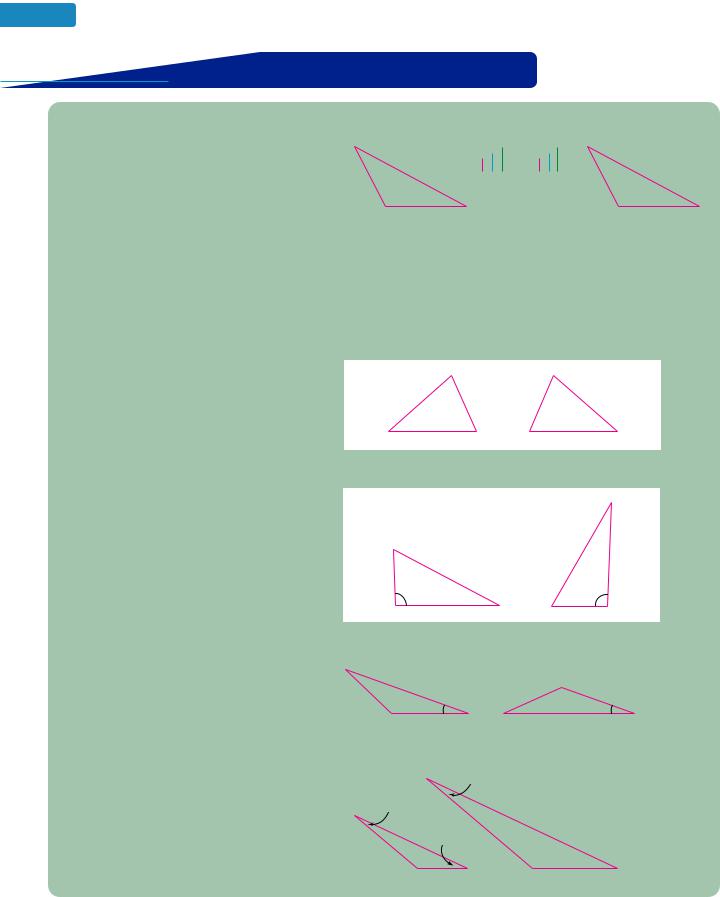
822 Chapter 9 An Introduction to Geometry
 S E C T I O N 9.5 Congruent Triangles and Similar Triangles
S E C T I O N 9.5 Congruent Triangles and Similar Triangles
|
DEFINITIONS AND CONCEPTS |
EXAMPLES |
|
|
|
|
|
|
|
|
|
|
|
|
|
|
|
|
|
|
|
|
|
|
|
|
|
|
|
|
If two triangles have the same size and the same |
C |
|
|
|
|
|
|
|
|
|
|
|
|
|
|
|
|
|
|
|
|
F |
|
|||||
|
shape, they are congruent triangles. |
|
|
|
|
|
|
|
|
|
|
|
|
|
|
|
|
|
|
|
|
|
|
|
|
|
|
|
|
|
|
|
|
|
|
|
|
|
|
|
|
|
|
|
|
|
|
|
|
|
|
|
|
|
|
|
|
|
|
|
|
|
|
|
|
|
|
|
|
|
|
|
|
|
|
|
|
|
|
|
|
|
|
|
|
|
|
|
|
|
|
|
|
|
|
|
|
|
|
|
|
|
|
|
|
|
|
|
|
|
|
|
|
|
|
|
|
|
|
|
|
|
|
|
|
|
|
|
|
|
|
|
|
|
|
|
|
|
|
|
|
|
|
||||||
|
|
|
|
ABC DEF |
|
||||||||||||||||||||||||
|
|
A |
B |
|
|
|
|
|
|
|
|
|
|
|
D |
E |
|||||||||||||
|
Corresponding parts of congruent triangles are |
There are six pairs of congruent parts: three pairs of congruent |
|||||||||||||||||||||||||||
|
congruent (have the same measure). |
angles and three pairs of congruent sides. |
|
||||||||||||||||||||||||||
|
|
• m( A) m( D) |
• m( |
|
) m( |
|
) |
|
|||||||||||||||||||||
|
|
BC |
EF |
|
|||||||||||||||||||||||||
|
|
• m( B) m( E) |
• m( |
|
|
) m( |
|
|
) |
|
|||||||||||||||||||
|
|
AC |
DF |
|
|||||||||||||||||||||||||
|
|
• m( C) m( F) |
• m( |
|
|
) m( |
|
|
|
) |
|
||||||||||||||||||
|
|
AB |
DE |
|
|||||||||||||||||||||||||
|
|
|
|
||||||||||||||||||||||||||
|
Three ways to show that two triangles are |
MNO RST by the SSS property. |
|
||||||||||||||||||||||||||
|
congruent are: |
|
O |
|
|
|
|
|
T |
|
|||||||||||||||||||
|
|
|
|
|
|
|
|
|
|||||||||||||||||||||
1.The SSS property If three sides of one triangle are congruent to three sides of a second triangle,
|
|
|
|
6 in. |
|
4 in. |
4 in. |
|
6 in. |
|
|
|
|
|
|
|
|
|
|
||
|
the triangles are congruent. |
|
|
|
|
|
|
MO RT |
|||||||||||||
|
|
|
|
|
|
|
|
|
|
|
|
|
|||||||||
|
|
|
|
M |
|
|
N |
S |
|
R |
|
|
MN |
|
|
|
RS |
|
|||
|
|
|
|
|
|
|
|
|
|
|
|
|
|
|
|
|
|||||
|
|
|
|
|
|
|
|
|
NO ST |
||||||||||||
|
|
|
|
|
7 in. |
|
|
|
|
7 in. |
|
|
|||||||||
2. |
The SAS property If two sides and the angle |
|
DEF XYZ by the SAS property. |
|
|
|
|
|
|
|
|
|
|
|
|||||||
|
between them in one triangle are congruent, |
|
|
|
|
|
|
|
|
|
Y |
|
|
|
|
|
|
|
|
|
|
|
respectively, to two sides and the angle between |
|
|
|
|
|
|
|
|
|
|
|
|
|
|
|
|
|
|
|
|
|
|
|
|
|
|
|
|
|
|
|
|
|
|
|
|
|
|
|
|
|
|
|
them in a second triangle, the triangles are |
|
|
|
|
|
|
|
|
|
|
|
|
|
|
|
|
|
|
|
|
|
congruent. |
|
|
F |
|
|
|
|
|
|
|
|
|
|
|
|
|
|
|
|
|
|
|
|
|
|
|
|
|
|
|
|
|
|
|
|
|
|
|
|
|
|
|
|
|
|
|
|
|
|
|
|
|
|
5 ft |
|
|
|
|
|
|
|
|
|
|
|
|
|
|
2 ft |
|
|
|
|
|
|
|
|
|
|
|
|
|
|
|
|
|
|
|
|
|
|
|
|
|
|
|
|
|
|
DF XZ |
||||||||
|
|
|
|
92° |
|
|
|
|
|
92° |
|
|
|||||||||
|
|
|
|
|
|
|
|
|
|
|
D X |
||||||||||
|
|
|
|
D |
|
|
|
E |
Z |
|
X |
|
|
||||||||
|
|
|
|
|
|
|
|
|
|
|
|
|
|
|
|
|
|
||||
|
|
|
|
5 ft |
|
|
|
|
|
DE XY |
|||||||||||
|
|
|
|
|
|
|
|
|
|
2 ft |
|
|
|||||||||
3. |
The ASA property If two angles and the side |
|
ABC TUV by the ASA property. |
|
|
|
|
|
|
|
|
|
|
|
|||||||
|
between them in one triangle are congruent, |
|
|
|
|
|
|
|
|
|
|
|
|
|
|
|
|
|
|
|
|
|
respectively, to two angles and the side between |
C |
|
|
|
|
|
|
T |
|
|
|
|
|
|
|
|
|
|
|
|
|
them in a second triangle, the triangles are |
|
|
|
|
|
|
|
|
10 m |
|
|
A T |
||||||||
|
|
|
|
|
|
|
|
|
135° |
|
|
||||||||||
|
congruent. |
|
|
|
|
|
|
|
|
|
|
|
|
|
|
|
|
|
|
|
|
|
|
|
135° |
20° |
|
|
|
|
20° |
|
|
AB TU |
|||||||||
|
|
|
|
|
|
|
|
|
|
||||||||||||
|
|
|
|
A |
10 m |
B |
|
V |
|
|
|
U |
|
B U |
|||||||
|
|
|
|
|
|
|
|
|
|
|
|
|
|||||||||
Similar triangles have the same shape, but not |
|
EFG WXY by the AAA similarity theorem. |
|
|
|
|
|
|
|
|
|
|
|||||||||
necessarily the same size. |
|
|
|
|
|
|
|
|
|
|
|
|
|
|
|
|
|
|
|
|
|
|
|
|
Y |
15° |
|
|
|
|
|
|
|
|
|
|
|
|
|
|
|||
We read the symbol as “is similar to.” |
|
|
|
|
|
|
|
|
|
|
|
|
|
|
|
|
|
||||
|
|
|
|
|
|
|
|
|
|
|
|
|
|
|
|
|
|
||||
|
|
|
|
|
|
|
|
|
|
|
|
|
|
|
|
|
|
|
|
||
AAA similarity theorem |
|
G |
15° |
|
|
|
|
|
|
|
|
|
|
|
|
|
|
|
|
|
|
If the angles of one triangle are congruent to |
|
|
|
|
|
|
|
|
|
|
|
|
|
|
|
|
|
|
|
||
|
|
|
|
|
|
|
|
|
|
|
|
|
|
|
|
|
|
|
|
||
corresponding angles of another triangle, the |
|
|
|
25° |
|
|
|
|
|
|
|
|
E W |
||||||||
triangles are similar. |
|
|
|
140° |
|
|
|
140° |
|
25° |
|
|
F X |
||||||||
|
|
|
|
|
|
|
|
|
|
|
G Y |
||||||||||
|
|
|
|
E |
|
F |
W |
|
X |
|
|||||||||||
|
|
|
|
|
|
|
|
|
|
|
|
|
|
|
|
|
|
|
|
|
|
|
|
|
|
|
|
|
|
|
|
|
|
|
|
|
|
|
|
|
|
|
|

Chapter 9 Summary and Review |
823 |
|
|
|
|
|
|
|
Property of similar triangles
If two triangles are similar, all pairs of corresponding sides are in proportion.
|
|
|
|
|
|
|
Similar triangles are |
|
|
|
|
|
|
|
determined by the |
|
|
|
|
|
|
|
tree and its shadow |
|
|
|
|
|
|
|
and the man and his |
|
|
|
|
|
|
h |
shadow. Since the |
|
|
|
|
|
|
|
triangles are similar, |
|
|
|
5 ft |
the lengths of their |
|||
|
|
|
|
|
|
|
corresponding sides |
3 ft |
|
|
27 ft |
are in proportion. |
|||
|
|
|
|||||
LANDSCAPING A tree casts a shadow 27 feet long at the same time as a man 5 feet tall casts a shadow 3 feet long. Find the height of the tree.
If we let h the height of the tree, we can find h by solving the following proportion.
The height of the tree |
|
|
|
h |
27 |
|
|
The length of the tree’s shadow |
|||||||
The height of the man |
|
|
|
|
|
|
|
|
The length of the man’s shadow |
||||||
|
|
|
5 |
3 |
|
|
|||||||||
|
3h |
5(27) |
Find each cross product and set them equal. |
||||||||||||
|
3h |
135 |
|
Do the multiplication. |
|||||||||||
|
3h |
135 |
|
To isolate h, divide both sides by 1.3. |
|||||||||||
|
|
|
|
|
|||||||||||
3 |
3 |
|
|||||||||||||
|
h |
45 |
|
Do the division. |
|
|
|
||||||||
The tree is 45 feet tall.
 REVIEW EXERCISES
REVIEW EXERCISES
49.Two congruent triangles are shown below. Complete the list of corresponding parts.
a. |
|
A corresponds to |
|
. |
|||
b. |
|
B corresponds to |
|
. |
|||
c. |
|
C corresponds to |
|
. |
|||
|
|
|
corresponds to |
|
. |
||
d. |
|
AC |
|||||
|
|
|
|
corresponds to |
|
. |
|
e. |
|
AB |
|||||
|
|
|
|
|
corresponds to |
|
. |
f. |
|
BC |
|||||
|
|
|
|
|
C |
F |
|
|
A |
|
|
B E |
D |
||
50.Refer to the figure below, where ABC XYZ. a. Find m( X).
52.
70° 70°
53.
70° |
|
70° |
|
|
|
60° |
50° |
60° |
50° |
|
|
54. |
|
|
|
|
|
50° |
60° |
50° |
60° |
|
|
|
6 cm |
6 cm |
|
||
Determine whether the triangles are similar. |
|
||||
55. |
|
|
|
56. |
35° |
|
|
|
|
|
|
|
50° |
50° |
|
|
|
50° |
50° |
|
|
|
|
|
|
|
|
35° |
|
b. |
Find m( C). |
|
|
|||
|
Find m( |
|
). |
|
|
|
c. |
YZ |
X |
|
|||
d. Find m( |
|
|
). |
|
|
|
AC |
|
|
||||
|
|
|
|
C |
9 in. |
|
|
|
|
|
|
|
|
|
|
|
|
6 in. |
|
|
|
32° |
|
|
|
61° |
Z |
|
|
|
|
|
||
A |
|
|
B |
Y |
|
|
|
|
|
|
|||
Determine whether the triangles in each pair are congruent. If they are, tell why.
51.
3 in. |
3 in. 3 in. |
3 in. |
3 in. |
|
3 in. |
57. In the figure below, RST MNO. Find x and y.
|
R |
N |
|
|
|
|
16 |
x |
|
|
|
|
32 |
M |
S |
7 |
|
|
|
|
|
y |
8 |
|
|
TO
58.HEIGHT OF A TREE A tree casts a 26-foot shadow at the same time a woman 5 feet tall casts a 2-foot shadow. What is the height of the tree? (Hint: Draw a diagram first and label the side lengths of the similar triangles.)
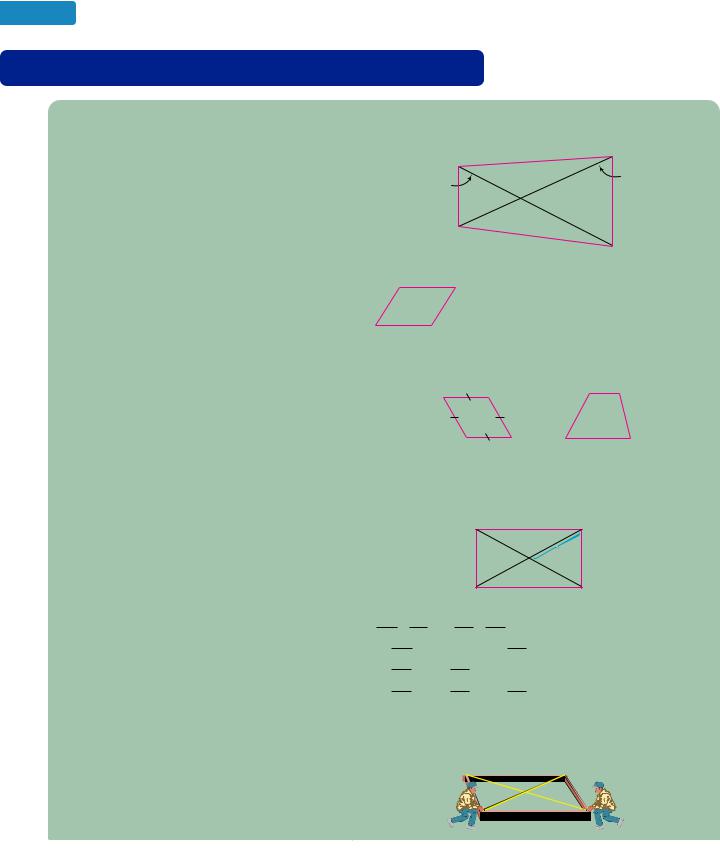
824 Chapter 9 An Introduction to Geometry
|
|
S E C T I O N 9.6 |
Quadrilaterals and Other Polygons |
|
|
|
|
|
|
|
|
|
|
|
|
|
|
|
|||
|
|
|
|
|
|
|
|
|
|
|
|
|
|
|
|
|
|
|
|
|
|
|
|
|
|
|
|
|
|
|
|
|
|
|
|
|
|
|
|
|
|
|
|
|
|
DEFINITIONS AND CONCEPTS |
EXAMPLES |
|
|
|
|
|
|
|
|
|
|
|
|
|
|
|
|||
|
|
A quadrilateral is a polygon with four sides. Use the |
|
|
|
Quadrilateral WXYZ |
|
|
|
|
|
|
|
|
|
|
|||||
|
|
capital letters that label the vertices of a quadrilateral |
|
W |
|
|
|
|
|
X |
|||||||||||
|
|
to name it. |
|
|
|
|
|
|
|
|
|
|
|
|
|
|
|
|
|
||
|
|
|
|
|
|
|
|
|
|
|
Diagonal XZ |
||||||||||
|
|
|
|
|
|
|
|
|
|
|
|
||||||||||
|
|
A segment that joins two nonconsecutive vertices of |
Diagonal WY |
|
|
|
|
|
|||||||||||||
|
|
|
|
|
|
|
|
|
|
|
|
|
|
|
|
|
|||||
|
|
a polygon is called a diagonal of the polygon. |
|
|
|
|
|
|
|
|
|
|
|
|
|
|
|
|
|
|
|
|
|
|
|
|
Z |
|
|
|
|
|
|
|
|
|
|
|
|
|
|
|
|
|
|
|
|
|
|
|
|
|
|
|
|
Y |
|||||||||
|
|
|
|
|
|
|
|
|
|
|
|
|
|
|
|
|
|
|
|
|
|
|
|
Some special types of quadrilaterals are shown on the |
|
|
|
|
|
|
|
|
|
|
|
|
|
|
|
|
|
|
|
|
|
|
|
|
|
|
|
|
|
|
|
|
|
|
|
|
|
|
|
||
|
|
right. |
|
|
|
|
|
|
|
|
|
|
|
|
|
|
|
|
|
|
|
|
|
|
|
|
|
|
|
|
|
|
|
|
|
|
|
|
|
|
|
|
|
|
|
|
|
|
|
|
|
|
|
|
|
|
|
|
|
|
|
|
|
|
|
|
|
|
|
Parallelogram |
Rectangle |
|
|
|
Square |
||||||||||||
|
|
|
|
(Opposite sides |
(Parallelogram with |
(Rectangle with |
|||||||||||||||
|
|
|
|
parallel) |
four right angles) |
sides of equal length) |
|||||||||||||||
|
|
|
Rhombus |
|
Trapezoid |
|
|
|
(Parallelogram with |
(Exactly two |
|
|
|
|
sides of equal length) |
sides parallel) |
|
A rectangle is a quadrilateral with four right angles. |
|
Rectangle ABCD |
|||
|
|
|
A |
30 in. |
B |
|
|
|
|
||
|
|
|
|
|
17 in. 16 in. |
|
|
|
|
E |
|
Properties of rectangles: |
|
D |
|
C |
|
|
|
|
|
||
1. |
All four angles are right angles. |
1. |
m( DAB) m( ABC) m( BCD) m( CDA) 90° |
||
2. |
Opposite sides are parallel. |
2. |
AD BC and AB DC |
|
|
3. |
Opposite sides have equal length. |
3. |
m(AD) 16 in. and m(DC) 30 in. |
||
4. |
Diagonals have equal length. |
4. |
m(DB) m(AC) 34 in. |
|
|
5. |
The diagonals intersect at their midpoints. |
5. |
m(DE) m(AE) m(EC) 17 in. |
||
Conditions that a parallelogram must meet to ensure |
Read Example 2 on page 769 to see how these two conditions are |
||||
that it is a rectangle: |
used in construction to “square a foundation.” |
||||
1. |
If a parallelogram has one right angle, then the |
|
A |
12 ft |
B |
|
parallelogram is a rectangle. |
|
|||
|
|
|
|
9 ft |
|
|
|
|
9 ft |
|
|
2. |
If the diagonals of a parallelogram are congruent, |
|
|
|
|
|
then the parallelogram is a rectangle. |
|
D |
12 ft |
C |
|
|
|
|||

A trapezoid is a quadrilateral with exactly two sides parallel.
The parallel sides of a trapezoid are called bases. The nonparallel sides are called legs.
If the legs (the nonparallel sides) of a trapezoid are of equal length, it is called an isosceles trapezoid.
In an isosceles trapezoid, both pairs of base angles are congruent.
The sum S, in degrees, of the measures of the angles of a polygon with n sides is given by the formula
S (n 2)180°
We can use the formula S (n 2)180° to find the number of sides a polygon has.
|
|
|
|
Chapter 9 Summary and Review |
825 |
|||||
|
|
|
Trapezoid ABCD |
|
|
|
|
|
||
|
A |
Upper base |
B |
|
|
|
|
|
||
|
|
|
Upper base |
|
|
|
|
|
|
|
|
|
|
|
angles |
|
|
|
|
|
|
|
Leg |
Leg |
AB || DC |
|
||||||
|
|
|
|
|||||||
|
|
|
|
|
|
|
|
|||
|
|
|
|
|
|
|
|
|
||
|
|
|
|
Lower base |
|
|
|
|
|
|
|
|
|
|
angles |
|
|
|
|
|
|
|
D |
|
Lower base |
C |
|
|||||
|
|
|
|
|
|
|
||||
|
|
|
|
|
|
|
|
|
||
Find the sum of the angle measures of a hexagon. |
|
|||||||||
Since a hexagon has 6 sides,we will substitute 6 for n in the formula. |
|
|||||||||
S (n 2)180° |
|
|
|
|
|
|
||||
S (6 2)180° Substitute 6 for n, the number of sides. |
|
|||||||||
(4)180° |
|
Do the subtraction within the parentheses. |
|
|||||||
720° |
|
|
Do the multiplication. |
|
|
|
|
|
||
The sum of the measures of the angles of a hexagon is 720°. |
|
|||||||||
The sum of the measures of the angles of a polygon is 2,340°. Find |
|
|||||||||
the number of sides the polygon has. |
|
|
|
|
|
|||||
|
S (n 2)180° |
|
|
|
|
|
|
|||
|
2,340° (n 2)180° |
Substitute 2,340° for S. |
|
|||||||
|
|
|
|
|
Now solve for n. |
|
|
|
|
|
|
2,340° 180°n 360° |
Distribute the multiplication by 180°. |
||||||||
2,340° 360° 180°n 360° 360° Add 360° to both sides. |
|
|||||||||
|
2,700° 180°n |
Do the addition. |
|
|
|
|
|
|||
2,700° |
|
180°n |
Divide both sides by 180°. |
|
||||||
|
180° |
180° |
|
|
||||||
|
15 n |
Do the division. |
|
|
|
|
|
|||
The polygon has 15 sides. |
|
|
|
|
|
|
||||
 REVIEW EXERCISES
REVIEW EXERCISES
59.Classify each of the following quadrilaterals as a parallelogram, a rectangle, a square, a rhombus, or a trapezoid. Some figures may be correctly classified in more than one way.
a. |
|
b. |
|
2 cm |
||||||||
|
|
2 cm |
|
|
|
|
|
2 cm |
||||
|
|
|
|
|
|
|
||||||
|
|
|
|
|
|
|
|
|
|
|
||
|
|
|
|
|
|
|
|
|
|
|
|
|
|
|
|
|
|
|
|
|
2 cm |
||||
c. |
2 ft |
d. |
|
|
|
|
|
|
|
|
||
|
|
|
|
|
|
|
|
|
||||
|
|
1 ft |
|
|
|
|
|
|
|
|
|
|
e. |
|
f. |
|
|
|
|
|
|
|
|
|
|
|
|
|
|
|
|
|
|
|
|
|
||
|
|
|
|
|
|
|
|
|
|
|
||
|
|
|
|
|
|
|
|
|
|
|
|
|
|
|
|
|
|
|
|
|
|
|
|
|
|
60.The length of diagonal AC of rectangle ABCD shown below is 15 centimeters. Find each measure.
a. |
m(BD) |
D |
14 cm |
C |
||
b. |
m( 1) |
|
40° |
|
||
c. |
m( 2) |
|
E 50° |
|
||
|
2 |
|
||||
|
|
|
|
|
|
|
d. |
m(EC) |
|
|
|||
|
1 |
|
||||
|
m( |
|
) |
A |
B |
|
e. |
AB |
|
||||
|
||||||
61.Refer to rectangle WXYZ below. Tell whether each statement is true or false.
a.m(WX) m(ZY)
b.m(ZE) m(EX)
c.Triangle WEX is isosceles.
d.m(WY) m(WX)
Z |
|
Y |
|
E |
|
W |
|
X |
|
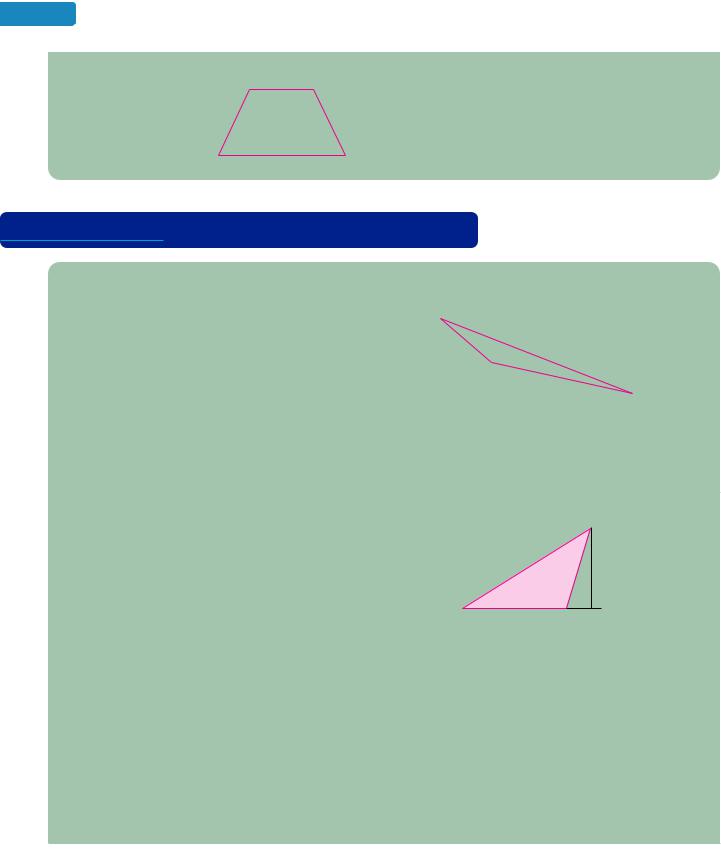
826 |
Chapter 9 An Introduction to Geometry |
|
|||||
62. Refer to isosceles trapezoid ABCD below. Find |
|||||||
each measure. |
|
3 yd |
|
||||
a. m( B) |
D |
C |
|||||
|
|||||||
|
115° |
|
|||||
b. m( C) |
|
|
|||||
4 yd |
|
|
|||||
|
m( |
|
) |
|
|
||
c. |
CB |
|
|
|
|||
|
|
|
|
65° |
|
B |
|
|
|
|
|
A |
|
||
7 yd
63.Find the sum of the angle measures of an octagon.
64.The sum of the measures of the angles of a polygon is 3,240°. Find the number of sides the polygon has.
 S E C T I O N 9.7 Perimeters and Areas of Polygons
S E C T I O N 9.7 Perimeters and Areas of Polygons
|
DEFINITIONS AND CONCEPTS |
EXAMPLES |
|
|||
|
The perimeter of a polygon is the distance around it. |
Find the perimeter of the triangle shown below. |
||||
|
|
|
|
|
|
|
|
|
Figure |
Perimeter Formula |
|
|
23 in. |
|
|
|
|
|
11 in. |
|
|
|
Square |
P 4s |
|
||
|
|
|
|
|||
|
|
|
|
|
||
|
|
Rectangle |
P 2l 2w |
|
|
16 in. |
|
|
Triangle |
P a b c |
|
|
|
|
|
|
|
|
||
|
|
|
|
|
P a b c |
This is the formula for the perimeter of a triangle. |
|
|
|
|
|
||
|
|
|
|
|
P 11 16 23 Substitute 11 for a, 16 for b, and 23 for c. |
|
|
|
|
|
|
50 |
Do the addition. |
The perimeter of the triangle is 50 inches.
The area of a polygon is the measure of the amount |
Find the area of the triangle shown here. |
|
|
|||||||||||||
of surface it encloses. |
|
|
|
|
|
|
|
|
|
|
|
|
|
|
|
|
|
|
|
|
|
|
|
|
|
|
|
|
|
|
|
|
|
|
Figure |
Area Formulas |
|
|
|
|
|
|
|
|
|
7 m |
|
|
||
|
|
|
|
|
|
|
|
|
|
|
|
|
|
|
|
3 m |
|
Square |
A s2 |
|
|
|
|
|
|
|
|
|
|
|
|
||
|
Rectangle |
A lw |
|
|
|
|
|
|
|
|
|
|
|
|
|
|
|
Parallelogram |
A bh |
|
|
|
|
|
|
|
|
|
5 m |
|
|
|
|
|
Triangle |
A 21 bh |
|
A |
1 |
bh |
|
|
|
This is the formula for the area of a triangle. |
||||||
|
Trapezoid |
A 21 h(b1 b2) |
|
2 |
|
|
|
|||||||||
|
|
|
|
A |
1 |
(5)(3) |
|
Substitute 5 for b, the length of the base, |
||||||||
|
|
|
|
|
|
and 3 for h, the height. Note that the side |
||||||||||
|
|
|
|
2 |
|
|||||||||||
|
|
|
|
|
|
|
|
|
|
|
|
length 7 m is not used in the calculation. |
||||
|
|
|
|
|
1 |
a |
5 |
b a |
3 |
b |
Write 5 as 5 and 3 as |
3. |
||||
|
|
|
|
2 |
1 |
|
||||||||||
|
|
|
|
|
|
|
1 |
|
1 |
|
|
1 |
||||
|
|
|
|
|
15 |
|
|
|
|
|
Multiply the numerators. |
|||||
|
|
|
|
2 |
|
|
|
|
|
Multiply the denominators. |
||||||
|
|
|
|
7.5 |
|
|
|
|
Do the division. |
|
|
|||||
The area of the triangle is 7.5 m2.
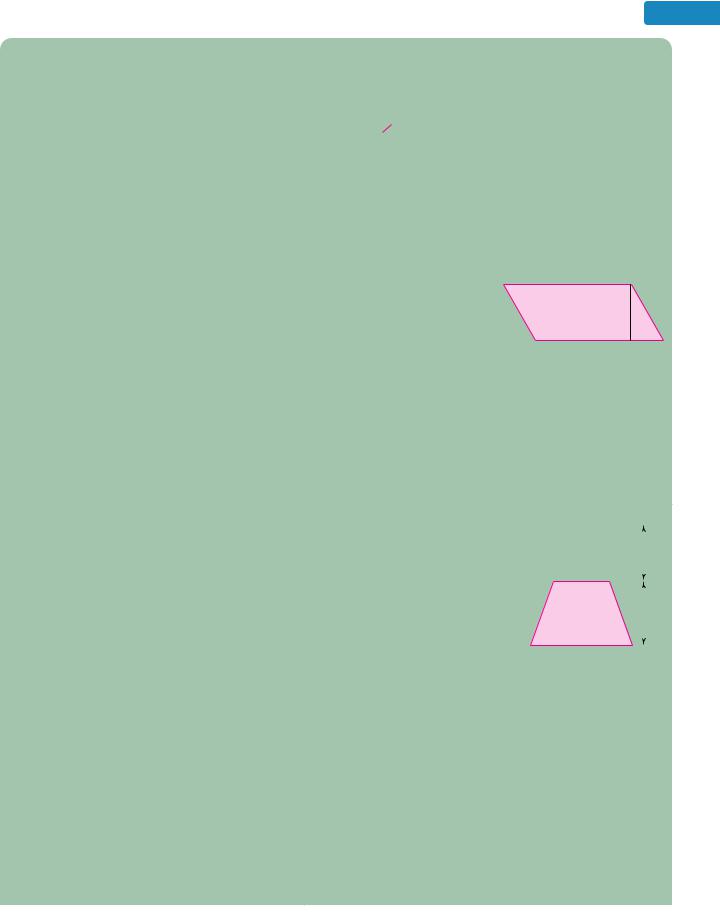
|
|
|
|
|
|
|
|
|
Chapter 9 |
Summary and Review |
827 |
||||||||
|
|
|
|
|
|
|
|
|
|
|
|
|
|
|
|||||
|
|
|
|
|
|
|
|
|
|
|
|
|
|
|
|||||
To find the perimeter or area of a polygon, all the |
To find the perimeter or area |
|
|
4 ft |
|
|
|
||||||||||||
measurements must be in the same units. If they are |
of the rectangle shown here, |
|
|
|
|
11 in. |
|
|
|
||||||||||
|
|
|
|
|
|
|
|||||||||||||
|
|
|
|
|
|
|
|||||||||||||
not, use unit conversion factors to change them to the |
we need to express the length |
|
|
|
|
|
|
|
|||||||||||
same unit. |
in inches. |
4 ft |
|
12 in. |
|
|
|
|
|
|
|
|
|
|
|
||||
|
Convert 4 feet to inches using a unit |
|
|
||||||||||||||||
|
|
4 ft |
|
|
|
||||||||||||||
|
|
1 |
|
1 ft |
conversion factor. |
|
|
||||||||||||
|
|
|
4 12 in. |
Remove the common units of feet in the |
|
|
|||||||||||||
|
|
|
|
|
|
|
|
|
numerator and denominator. The unit of |
|
|
||||||||
|
|
|
|
|
|
|
|
|
inches remain. |
|
|
|
|
|
|
|
|
||
|
|
|
48 in. |
|
Do the multiplication. |
|
|
||||||||||||
|
The length of the rectangle is 48 inches. Now we can find the |
|
|
||||||||||||||||
|
perimeter (in inches) or area (in in.2) of the rectangle. |
|
|
||||||||||||||||
|
|
|
|
|
|
|
|
|
|
|
|
|
|
|
|
|
|||
If we know the area of a polygon, we can often use |
The area of the parallelogram |
|
|
|
|
|
|
|
|
|
|||||||||
|
|
|
|
|
|
|
|
|
|||||||||||
algebra to find an unknown measurement. |
shown here is 208 ft2. Find the |
|
|
|
|
|
|
|
|
|
|||||||||
|
height. |
|
|
|
|
|
|
|
|
|
h |
|
|
||||||
|
|
|
|
|
|
|
|
|
|
|
|
|
|
|
|
|
|
|
|
|
|
|
|
|
|
|
|
|
|
|
|
|
|
|
|
|
|
|
|
|
|
|
|
|
|
|
|
|
|
|
|
26 ft |
|
|
|||||
|
|
A bh |
|
This is the formula for the area of a parallelogram. |
|
|
|||||||||||||
|
|
208 26h |
Substitute 208 for A, the area, and 26 for b, |
|
|
||||||||||||||
|
|
|
|
|
|
|
|
the length of the base. |
|
|
|
|
|
|
|
|
|||
|
|
208 |
|
|
26h |
|
To isolate h, undo the multiplication by 26 |
|
|
||||||||||
|
|
26 |
26 |
|
|
by dividing both sides by 26. |
|
|
|||||||||||
|
|
8 h |
|
Do the division. |
|
|
|
|
|
|
|
|
|||||||
The height of the parallelogram is 8 feet.
To find the area of an irregular shape, break up the |
Find the area of the shaded figure |
|
|
8 cm |
|
||||||||||||||
shape into familiar polygons. Find the area of each |
shown here. |
|
|
|
|
|
|
|
|
|
|
|
|
|
|
||||
|
|
|
|
|
|
|
|
|
|
|
|
|
|
||||||
polygon, and then add the results. |
|
|
|
|
|
|
|
|
|
|
|
|
|
|
|
|
|
|
|
We will find the area of the lower |
|
|
|
|
|
8 cm |
|
||||||||||||
|
|
|
|
|
|
|
|||||||||||||
|
portion of the figure (the trapezoid) |
|
|
|
|
|
|
|
|
|
|
|
|||||||
|
and the area of the upper portion |
|
|
|
|
|
|
|
|
|
|
|
|||||||
|
|
|
|
|
|
|
|
|
|
|
|
||||||||
|
|
|
|
|
|
|
|
|
|
|
|
||||||||
|
(the square) and then add the results. |
|
|
|
|
|
10 |
|
cm |
|
|||||||||
|
|
|
|
|
|
|
|
|
|
|
|
|
|
|
|
||||
|
|
|
|
|
|
|
|
|
|
|
|
|
|
|
|
|
|
|
|
|
|
|
|
|
|
|
|
|
|
|
|
|
|
|
|
|
|
|
|
|
|
|
|
|
|
|
|
|
|
|
18 cm |
|
|||||||
|
A |
|
|
|
1 |
h(b |
b ) |
This is the formula for the area of a |
|||||||||||
|
trapezoid |
|
2 |
1 |
2 |
trapezoid. |
|
|
|
|
|
|
|
|
|
|
|
||
|
|
|
|
|
|
|
|
|
|
|
|
|
|
|
|
|
|||
|
Atrapezoid |
|
1 |
(10)(8 18) |
Substitute 8 for b1, 18 for b2, and |
||||||||||||||
|
2 |
10 for h. |
|
|
|
|
|
|
|
|
|
|
|
||||||
|
|
|
|
1 |
(10)(26) |
Do the addition within the parentheses. |
|||||||||||||
|
|
|
|
|
|||||||||||||||
|
|
|
2 |
||||||||||||||||
|
|
|
130 |
|
Do the multiplication. |
||||||||||||||
|
The area of the trapezoid is 130 cm2. |
|
|
|
|
|
|
|
|
|
|
|
|||||||
|
|
Asquare s2 |
This is the formula for the area of a square. |
||||||||||||||||
|
|
Asquare 82 |
Substitute 8 for s. |
|
|
|
|
|
|
|
|
|
|
|
|||||
|
|
|
|
64 |
Evaluate the exponential expression. |
||||||||||||||
The area of the square is 64 cm2.
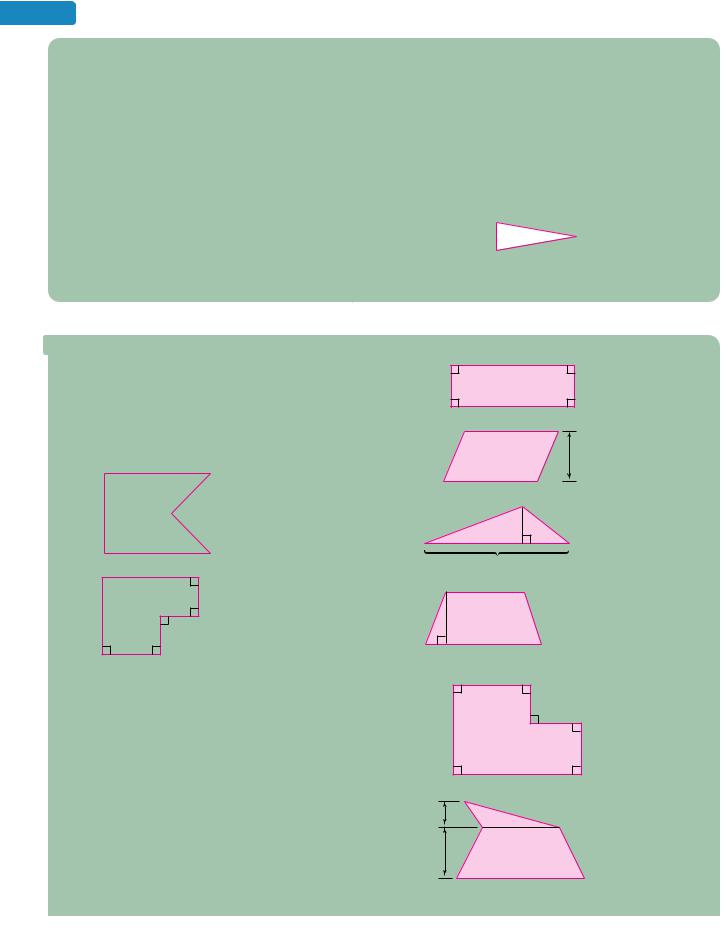
828 |
Chapter 9 An Introduction to Geometry |
|
|
|
|
|
|
|
|
|
|
|
|
|
|
|
|
|
|
|
|
|
|
|
|
|
The total area of the shaded figure is |
||||
|
|
|
Atotal Atrapezoid Asquare |
||||
|
|
|
Atotal 130 cm2 64 cm2 |
||||
|
|
|
194 cm2 |
||||
|
|
|
The area of the shaded figure is 194 cm2. |
||||
|
|
|
|
|
|
|
|
|
|
To find the area of an irregular shape, we must |
To find the area of the shaded figure below, we subtract the area |
||||
|
|
sometimes use subtraction. |
of the triangle from the area of the rectangle. |
||||
|
|
|
|
|
|
|
|
|
|
|
|
|
|
|
|
|
|
|
|
|
|
|
|
|
|
|
|
|
|
|
|
Ashaded Arectangle Atriangle
 REVIEW EXERCISES
REVIEW EXERCISES
65.Find the perimeter of a square with sides 18 inches long.
66.Find the perimeter (in inches) of a rectangle that is 7 inches long and 3 feet wide.
Find the perimeter of each polygon.
67.8 m
4 m
6 m
4 m
8m
68.
4 m
8 m
4 m
6m
69.The perimeter of an isosceles triangle is 107 feet. If one of the congruent sides is 24 feet long, how long is the base?
70.a. How many square feet are there in 1 square yard?
b.How many square inches are in 1 square foot?
Find the area of each polygon.
71.3.1 cm
3.1 cm |
|
|
|
3.1 cm |
|
|
|
||
|
|
|
|
|
|
|
|
|
|
3.1 cm
72.
50 ft
150 ft
73.
20 ft |
15 ft |
30 ft
74.
10 in.
40in.
75.12 cm
8 cm
18cm
76.12 ft
14 ft
8 ft
20 ft
77.
4 ft
12 ft
8 ft
20 ft
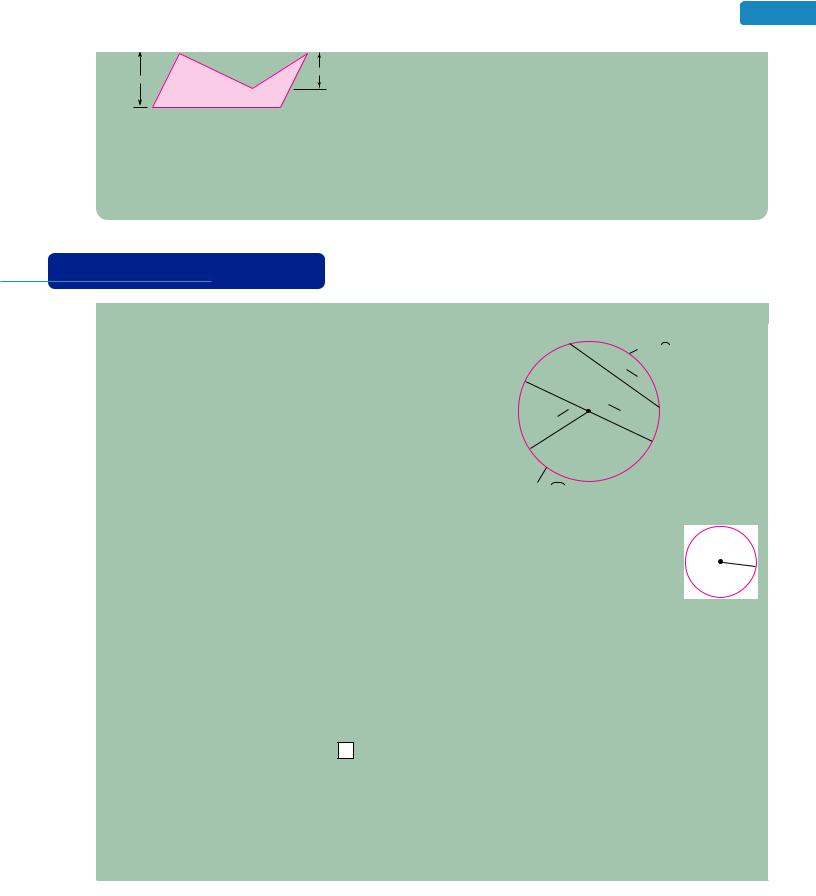
78.
4 m
10 m
15m
79.The area of a parallelogram is 240 ft2. If the length of the base is 30 feet, what is its height?
80.The perimeter of a rectangle is 48 mm and its width is 6 mm. Find its length.
Chapter 9 Summary and Review |
829 |
81.FENCES A man wants to enclose a rectangular front yard with chain link that costs $8.50 a foot (the price includes installation). Find the cost of enclosing the yard if its dimensions are 115 ft by 78 ft.
82.LAWNS A family is going to have artificial turf installed in their rectangular backyard that is 36 feet long and 24 feet wide. If the turf costs $48 per square yard, and the installation is free, what will this project cost? (Assume no waste.)
 S E C T I O N 9.8 Circles
S E C T I O N 9.8 Circles
 DEFINITIONS AND CONCEPTS
DEFINITIONS AND CONCEPTS
A circle is the set of all points in a plane that lie a fixed distance from a point called its center. The fixed distance is the circle’s radius.
A chord of a circle is a line segment connecting two points on the circle.
A diameter is a chord that passes through the circle’s center.
Any part of a circle is called an arc.
A semicircle is an arc of a circle whose endpoints are the endpoints of a diameter.
The circumference (perimeter) of a circle is given by the formulas
C pD or C 2pr
where p 3.14159 . . . .
If an exact answer contains p, we can use 3.14 as an approximation, and complete the calculations by hand. Or, we can use a calculator that has a pi key p to find an approximation.
EXAMPLES
|
A |
|
|
|
Arc AB |
|
|
|
Chord |
||
C |
|
|
AB |
||
|
|
|
|
||
|
Diameter |
CD |
B |
||
|
|
O |
|
|
|
Radius |
OE |
|
|
|
|
|
|
|
|
|
|
D
E
Semicircle CED
Find the circumference of the circle shown here.
Give the exact answer and an approximation.
8 in.
C 2pr This is the formula for the circumference of a circle.
C 2p(8) Substitute 8 for r, the radius.
C 2(8)p Rewrite the product so that P is the last factor.
C 16p Do the first multiplication: 2(8) 16. This is the exact answer.
The circumference of the circle is exactly 16p inches. If we replace p with 3.14, we get an approximation of the circumference.
C 16P
C 16(3.14) Substitute 3.14 for P.
C 50.24 Do the multiplication.
The circumference of the circle is approximately 50.2 inches.
We can also use a calculator to approximate 16p.
C 50.26548246
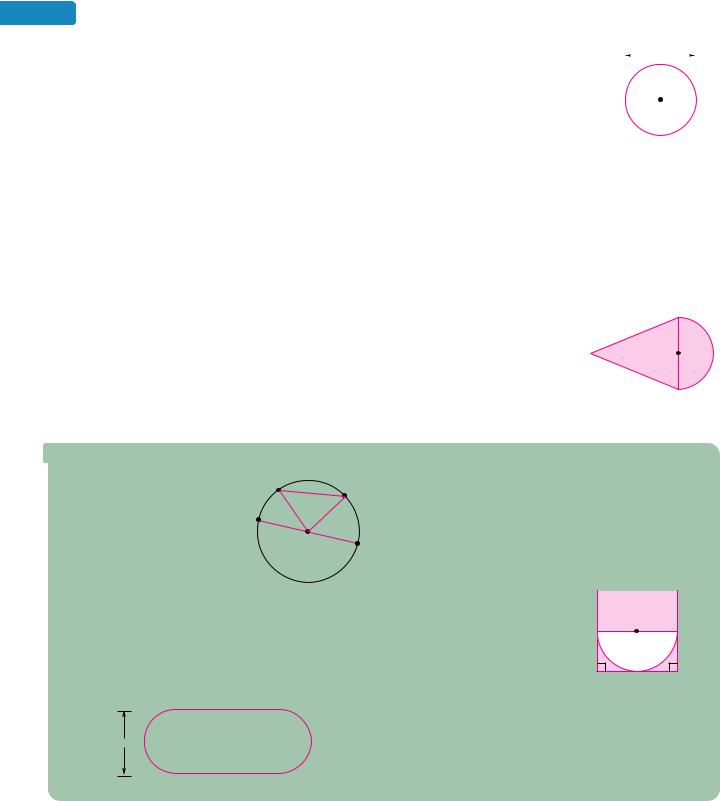
830 |
Chapter 9 An Introduction to Geometry |
|
|
|
|
|
|
|
|
|
|
|
|
|
|
|
|
|
|
|
|
|
|
|
|
|
|
|
|
|
|
|
|
|
|
|
|
|
|
|
The area of a circle is given by the formula |
Find the area of the circle shown here. Give |
|
|
28 m |
|
|
|
|
||
|
|
|
|
|
|
|
||||||
|
|
A pr2 |
the exact answer and an approximation to the |
|
|
|
|
|
|
|
||
|
|
|
nearest tenth. |
|
|
|
|
|
|
|
|
|
|
|
|
Since the diameter is 28 meters, the radius is |
|
|
|
|
|
|
|
||
|
|
|
half of that, or 14 meters. |
|
|
|
|
|
|
|
||
|
|
|
A pr2 |
|
|
|
|
|
|
|
|
|
|
|
|
This is the formula for the area of a circle. |
|||||||||
|
|
|
A p(14)2 |
Substitute 14 for r, the radius of the circle. |
||||||||
|
|
|
p(196) |
Evaluate the exponential expression. |
|
|
|
|
|
|||
|
|
|
196p |
Write the product so that p is the last factor. |
||||||||
|
|
|
The exact area of the circle is 196p m2. We can use a calculator to |
|||||||||
|
|
|
approximate the area. |
|
|
|
|
|
||||
|
|
|
A 615.7521601 Use a calculator to do the multiplication. |
|||||||||
|
|
|
To the nearest tenth, the area is 615.8 m2. |
|
|
|
|
|
||||
|
|
To find the area of an irregular shape, break it up into |
To find the area of the shaded figure |
|
|
|
|
|
|
|||
|
|
|
|
|
|
|
|
|||||
|
|
familiar figures. |
shown here, find the area of the triangle |
|
|
|
|
|
|
|||
|
|
|
and the area of the semicircle, and then |
|
|
|
|
|
|
|||
|
|
|
add the results. |
|
|
|
|
|
|
|
|
|
|
|
|
Ashaded figure Atriangle Asemicircle |
|
|
|
|
|
|
|||
|
|
|
|
|
|
|
|
|
||||
|
|
|
|
|
|
|
|
|
|
|
|
|
 REVIEW EXERCISES
REVIEW EXERCISES
83. Refer to the figure. |
C |
D |
|
a. |
Name each chord. |
|
|
|
|
||
b. |
Name each diameter. |
A |
|
|
|
||
c. |
Name each radius. |
O |
B |
|
|||
d. Name the center.
84.Find the circumference of a circle with a diameter of 21 feet. Give the exact answer and an approximation to the nearest hundredth.
85.Find the perimeter of the figure shown below. Round to the nearest tenth.
86.Find the area of a circle with a diameter of 18 inches. Give the exact answer and an approximation to the nearest hundredth.
87.Find the area of the figure shown in Problem 85. Round to the nearest tenth.
88. Find the area of the shaded |
|
100 in. |
|
region shown on the right. |
|
||
|
|
|
|
|
|
|
|
Round to the nearest tenth. |
|
|
|
100 in.
10 cm
8 cm
10 cm
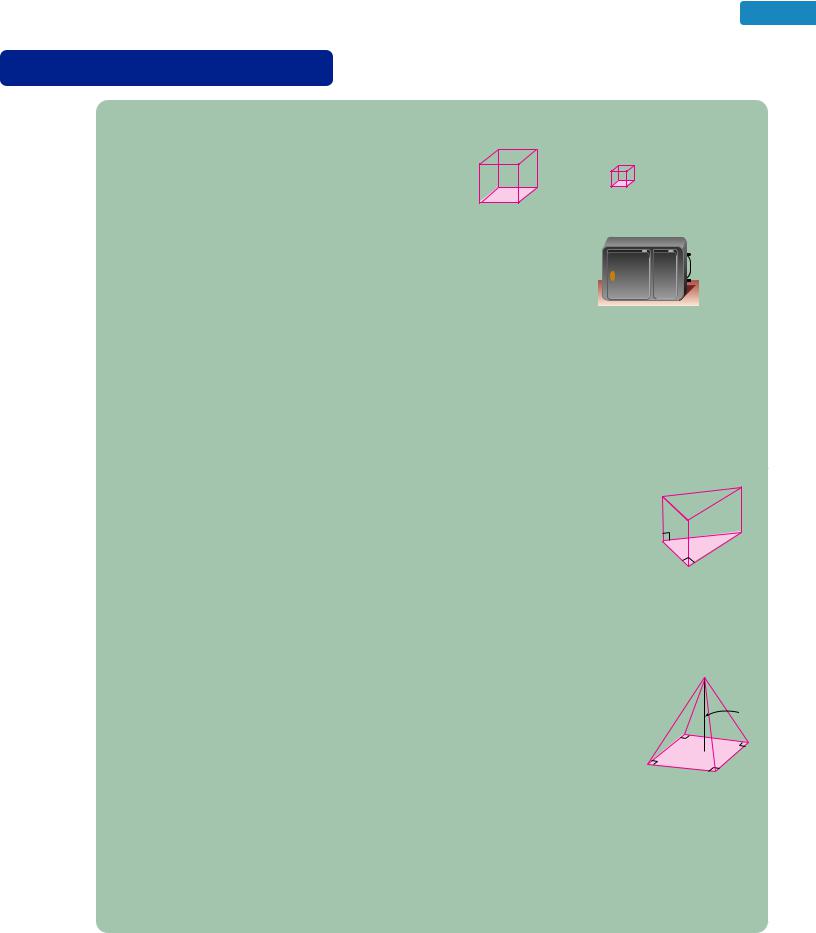
|
|
|
|
|
|
|
Chapter 9 |
Summary and Review |
831 |
||
|
S E C T I O N 9.9 |
Volume |
|
|
|
|
|
|
|||
|
|
|
|
|
|
|
|||||
|
|
|
|
|
|
|
|
|
|
|
|
|
|
|
|
|
|
|
|
|
|
|
|
|
DEFINITIONS AND CONCEPTS |
EXAMPLES |
|
|
|
|
|
||||
|
The volume of a figure can be thought of as the |
1 cubic inch: 1 in.3 1 cubic centimeter: 1 cm3 |
|
|
|||||||
|
number of cubic units that will fit within its boundaries. |
|
|
|
|
|
|
||||
|
Two common units of volume are cubic inches (in.3) |
|
1 in. |
1 cm |
|
|
|||||
|
and cubic centimeters (cm3). |
|
|
1 cm |
|
|
|||||
|
|
|
|
|
|
|
1 in. |
1 cm |
|
|
|
|
|
|
|
|
|
1 in. |
|
|
|
|
|
|
|
|
|
|
|
|
|
|
|
|
|
|
|
|
|
|
|
|
|||||
|
The volume of a solid is a measure of the space it |
CARRY-ON LUGGAGE The |
|
Width: 17 in. |
|
|
|||||
|
occupies. |
|
|
|
largest carry-on bag that Alaska |
|
|
|
|
||
|
|
|
|
|
|
|
|
||||
|
|
|
|
|
|
Airlines allows on board a flight |
|
Height: 10 in. |
|
|
|
|
|
Figure |
|
Volume Formula |
|
is shown on the right. Find the |
|
|
|
|
|
|
|
|
|
|
|
|
|
||||
|
|
|
|
|
|
volume of space that a bag that |
|
|
|
|
|
|
|
Cube |
|
V s3 |
|
Length: 24 in. |
|
|
|||
|
|
|
|
|
|
size occupies. |
|
|
|
|
|
|
|
Rectangular solid |
V lwh |
|
|
|
|
|
|
||
|
|
|
V lwh |
This is the formula for the volume of a |
|
|
|||||
|
|
Prism |
|
V Bh* |
|
|
|
||||
|
|
|
|
|
rectangular solid. |
|
|
||||
|
|
Pyramid |
|
V 31 Bh* |
|
V 24(17)(10) |
Substitute 24 for l, the length, 17 for w, the |
|
|
||
|
|
Cylinder |
|
V pr2h |
|
|
width, and 10 for h, the height of the bag. |
|
|
||
|
|
Cone |
|
V 31 pr2h |
|
4,080 |
Do the multiplication. |
|
|
||
|
|
Sphere |
|
V 34 pr3 |
|
The volume of the space that the bag occupies is 4,080 in.3. |
|
|
|||
*B represents the area of the base.
Caution! When finding the volume of a figure, only |
Find the volume of the prism shown here. |
|
5 ft |
||||||||||||
use the measurements that |
are called for in |
the |
The area of |
the triangular base of the |
|
|
|
|
|
|
|||||
formula. Sometimes a figure |
may be labeled |
with |
|
|
|
|
|
|
|||||||
prism is |
1 |
|
|
|
|
|
|
|
|
9 ft |
|||||
measurements that are not used. |
|
2 (3)(4) 6 square feet. (The 5- |
|
|
|
|
|
|
|||||||
|
inch measurement is not used.) To find the |
|
|
|
|
|
|
||||||||
|
|
|
|
|
|
|
|
|
|
||||||
|
|
|
|
volume of the prism, proceed as follows: |
3 ft |
|
|
|
|
4 ft |
|||||
|
|
|
|
|
|
|
|
|
|
|
|
|
|
||
|
|
|
|
V Bh |
|
This is the formula for the volume of a prism. |
|||||||||
|
|
|
|
V 6(9) |
Substitute 6 for B, the area of the base, and 9 for h, |
||||||||||
|
|
|
|
|
|
|
|
|
the height. |
|
|
|
|
|
|
|
|
|
|
54 |
|
Do the multiplication. |
|
|
|
|
|
|
|||
|
|
|
|
The volume of the triangular prism is 54 ft3. |
|
|
|
|
|
|
|||||
|
|
|
|
|
|
|
|
|
|
||||||
The letter B appears in two of the volume formulas. |
Find the volume of the pyramid shown here. |
|
|
|
|
|
|
||||||||
It represents the area of the base of the figure. |
|
Since the base is a square with each side |
|
|
|
|
|
|
|||||||
|
|
|
|
|
|
|
|
|
6 cm |
||||||
Note that the volume formulas for a pyramid and a |
5 centimeters long, the area of the base is |
|
|
|
|
|
|||||||||
|
|
|
|
|
|
||||||||||
cone contain a factor of 31 . |
|
|
5 5 25 cm2. |
|
|
|
|
|
|
|
|||||
Cone: |
V 31 pr2h |
|
|
|
|
|
|
|
|
|
|
|
|
|
5 cm |
|
|
|
|
|
|
|
|
|
|
|
|
|
|||
Pyramid: |
1 |
|
|
|
|
|
|
|
|
5 cm |
|
|
|
|
|
V 3 Bh |
|
|
|
1 |
|
|
|
|
|
|
|
|
|
||
|
|
|
|
V |
Bh |
|
This is the formula for the volume of a pyramid. |
||||||||
|
|
|
|
|
3 |
|
|||||||||
|
|
|
|
|
1 |
|
|
Substitute 25 for B, the area of the base, and 6 |
|||||||
|
|
|
|
V |
|
|
(25)(6) for h, the height. |
|
|
|
|
|
|
||
|
|
|
|
|
3 |
|
|
|
|
|
|
||||
|
|
|
|
25(2) |
Multiply the first and third factors: |
1 |
(6) 2. |
||||||||
|
|
|
|
|
|||||||||||
|
|
|
|
|
|
|
|
|
|
|
3 |
|
|
|
|
|
|
|
|
50 |
|
Complete the multiplication by 25. |
|
|
|
|
|
||||
|
|
|
|
The volume of the pyramid is 50 cm3. |
|
|
|
|
|
|
|||||
|
|
|
|
|
|
|
|
|
|
|
|
|
|
|
|
|
|
|
|
|
|
|
|
|
|
|
|
|
|
|
|
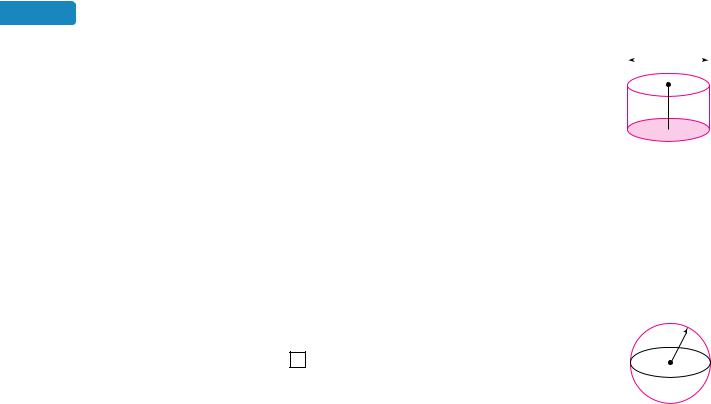
832 |
Chapter 9 |
An Introduction to Geometry |
|
|
|
|
|
|
|
|
|
|
|
|
|
|||
|
|
|
|
|
|
|
|
|
|
|
|
|
|
|
|
|||
|
|
|
|
|
|
|
|
|
|
|
|
|
|
|||||
|
|
Note that the volume formulas for a cone, cylinder, |
Find the volume of the cylinder shown here. |
|
|
8 yd |
|
|
|
|||||||||
|
|
|
|
|||||||||||||||
|
|
and sphere contain a factor of p. |
Give the exact answer and an approximation |
|
|
|
|
|
|
|
||||||||
|
|
Cone |
V 1 Pr2h |
to the nearest hundredth. |
|
|
|
|
|
|
||||||||
|
|
|
|
|
|
|
|
|
|
|
|
|
|
|
||||
|
|
|
3 |
|
|
Since a radius is one-half of the diameter of |
|
|
3 yd |
|||||||||
|
|
Cylinder |
V Pr2h |
|
|
|||||||||||||
|
|
|
|
|
|
1 |
|
|
|
|
|
|
|
|
||||
|
|
Sphere |
V 34 Pr3 |
the circular base, r 2 8 yd 4 yd. To find |
|
|
|
|
|
|
||||||||
|
|
|
|
|
|
|
|
|||||||||||
|
|
the volume of the cylinder, proceed as follows: |
|
|
|
|
|
|
||||||||||
|
|
|
|
|
|
V pr2h |
This is the formula for the volume of a cylinder. |
|||||||||||
|
|
|
|
|
|
V p(4)2(3) |
Substitute 4 for r, the radius of the base, and |
|||||||||||
|
|
|
|
|
|
|
|
|
|
3 for h, the height. |
|
|
|
|
|
|
||
|
|
|
|
|
|
V p(16)(3) |
Evaluate the exponential expression. |
|
|
|
|
|
|
|||||
|
|
|
|
|
|
48p |
Write the product so that P is the last factor. |
|||||||||||
|
|
|
|
|
|
150.7964474 Use a calculator to do the multiplication. |
||||||||||||
|
|
|
|
|
|
The exact volume of the cylinder is 48p yd3. To the nearest |
||||||||||||
|
|
|
|
|
|
hundredth, the volume is 150.80 yd3. |
|
|
|
|
|
|
||||||
|
|
If an exact answer contains p, we can use 3.14 as an |
Find the volume of the sphere shown here. Give |
|
|
|
|
|
|
|||||||||
|
|
approximation, and complete the calculations by hand. |
the exact answer and an approximation to the |
|
|
6 ft |
||||||||||||
|
|
Or, we can use a calculator that has a pi key |
p |
to find |
nearest tenth. |
|
|
|
|
|
||||||||
|
|
an approximation. |
|
4 |
|
|
|
|
|
|
|
|
|
|
|
|||
|
|
|
|
|
|
V |
pr3 |
This is the formula for the |
|
|
|
|
|
|
||||
|
|
|
|
|
|
3 |
|
|
|
|
|
|
||||||
|
|
|
|
|
|
|
|
|
volume of a sphere. |
|
|
|
|
|
|
|||
|
|
|
|
|
|
|
|
|
|
|
|
|
|
|
|
|||
|
|
|
|
|
|
V |
4 |
p(6)3 |
Substitute 6 for r, the radius of the sphere. |
|||||||||
|
|
|
|
|
|
3 |
||||||||||||
|
|
|
|
|
|
|
|
|
|
|
|
|
|
|
|
|
|
|
|
|
|
|
|
|
|
4 |
p(216) |
Evaluate the exponential expression. |
|
|
|
|
|
|
|||
|
|
|
|
|
|
3 |
|
|
|
|
|
|
||||||
|
|
|
|
|
|
|
864 |
p |
Multiply: 4(216) 864. |
|
|
|
|
|
|
|||
|
|
|
|
|
|
3 |
|
|
|
|
|
|
||||||
|
|
|
|
|
|
288p |
Divide: 864 288. |
|
|
|
|
|
|
|||||
|
|
|
|
|
|
|
|
|
|
3 |
|
|
|
|
|
|
|
|
|
|
|
|
|
|
904.7786842 Use a calculator to do the multiplication. |
||||||||||||
|
|
|
|
|
|
The volume of the sphere is exactly 288p ft3 .To the nearest tenth, |
||||||||||||
|
|
|
|
|
|
this is 904.8 ft3. |
|
|
|
|
|
|
|
|
|
|||
|
|
|
|
|
|
|
|
|
|
|
|
|
|
|
|
|
|
|
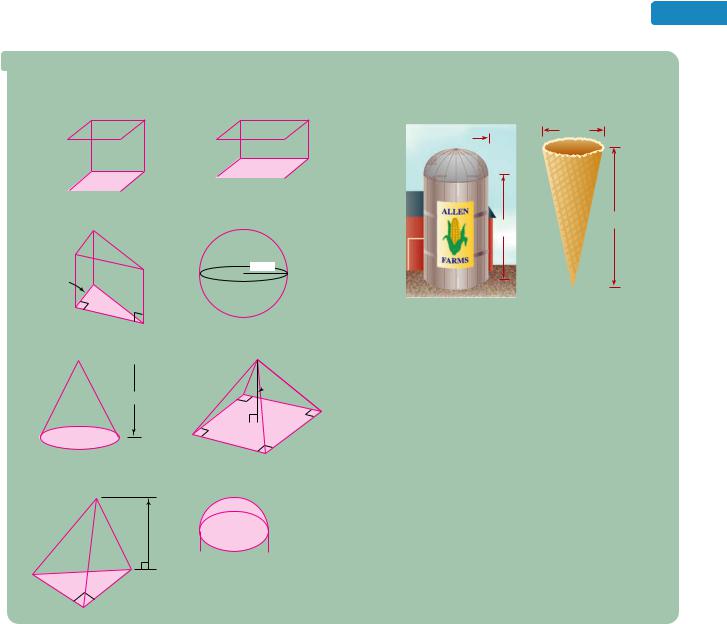
 REVIEW EXERCISES
REVIEW EXERCISES
Find the volume of each figure. If an exact answer contains P, approximate to the nearest hundredth.
89. 90.
5 cm |
|
|
8 m |
|
|
|
|
|
|
6 m |
|
|
|
|
|
|
|
|
|
5 cm |
|
10 m |
|
|
5 cm |
|
|
|
|
91. 92.
25 mm
5 in.
12 mm
18 mm
16 mm
93.  94.
94.
 15 yd
15 yd
30 in.
20 yd
20 yd
 10 in.
10 in. 

95. 96.
42 m
 16 in.
16 in. 

12 m |
35 m |
|
Chapter 9 Summary and Review |
833 |
97.FARMING Find the volume of the corn silo shown below. Round to the nearest one cubic foot.
2.5 in.
 10 ft
10 ft
6 in.
16 ft
98.WAFFLE CONES Find the volume of the ice cream cone shown above. Give the exact answer and an approximation to the nearest tenth.
99.How many cubic inches are there in 1 cubic foot?
100.How many cubic feet are there in 2 cubic yards?

834
C H A P T E R 9 TEST
1.Estimate each angle measure. Then tell whether it is an acute, right, obtuse, or straight angle.
a. |
b. |
c.
d.
2.Fill in the blanks.
a.If ABC DEF, then the angles have the same
|
|
. |
|
|
|
|
|
|
b. |
Two congruent segments have the same |
. |
||||||
c. |
Two different points determine one |
|
|
|
. |
|
||
d. |
Two angles are called |
|
if the sum of |
|||||
|
their measures is 90°. |
|
|
|
|
|||
5. Find x. Then find m( ABD) and m( CBE).
A |
C |
3x |
2x + 20° |
|
B |
D |
E |
6.Find the supplement of a 47° angle.
7.Refer to the figure below. Fill in the blanks.
a. l1 intersects two coplanar lines. It is called a
.
b. |
4 and |
|
are alternate interior angles. |
||
c. |
3 and |
|
are corresponding angles. |
||
|
|
|
|
|
l1 |
|
|
|
|
|
1 |
|
|
|
|
4 |
2 |
|
|
|
|
3 |
|
|
|
|
|
|
|
|
|
5 |
6 |
|
|
|
|
8 |
7 |
|
|
|
|
|
|
|
|
3.Refer to the figure below. What is the midpoint of BE?
A |
|
B |
C |
D |
|
E |
|
|
|
|
|
|
|
|
|
2 |
3 |
4 |
5 |
6 |
7 |
8 |
9 |
4.Refer to the figure below and tell whether each statement is true or false.
a.AGF and BGC are vertical angles.
b.EGF and DGE are adjacent angles.
c.m( AGB) m( EGD).
d.CGD and DGF are supplementary angles.
e.EGD and AGB are complementary angles.
A
B
F
C
G
E
D
8. In the figure below, l1 l2 and m( 2) 25°. Find the measures of the other numbered angles.
|
|
1 |
2 |
l1 |
|
5 |
|
6 |
|
|
|
|
||
|
3 |
7 |
|
l2 |
4 |
8 |
|
|
|
|
|
|
9. In the figure below, l1 l2. Find x. Then determine the measure of each angle that is labeled in the figure.
|
l1 |
|
x + 20° |
||
|
2x + 10°
 l2
l2
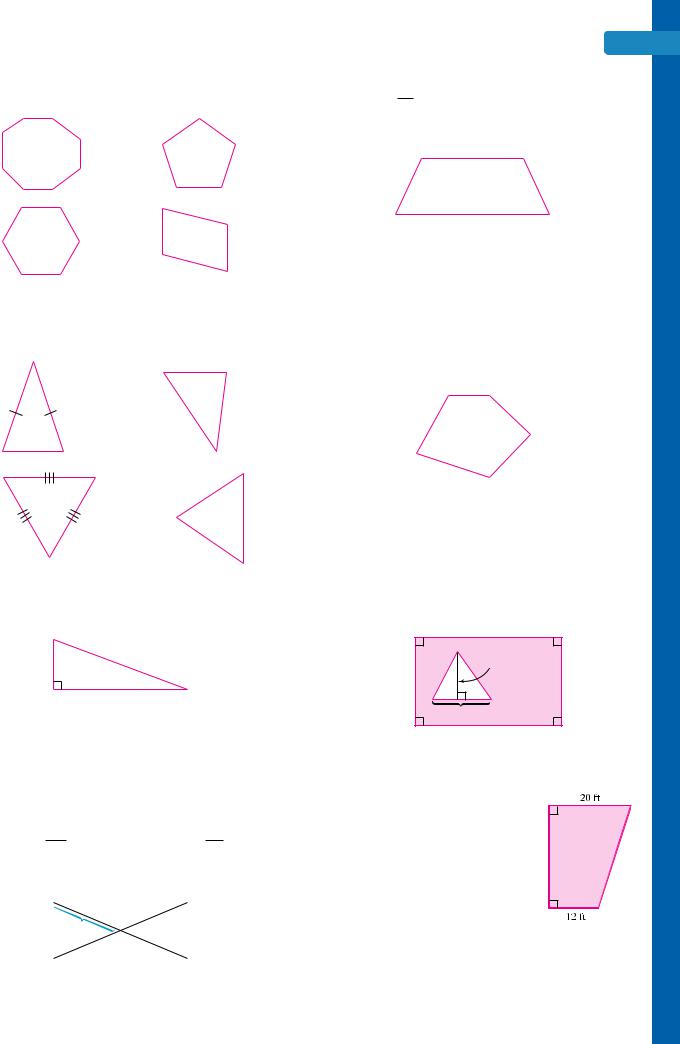
10.For each polygon, give the number of sides it has, tell its name, and then give the number of vertices it has.
a. |
b. |
c. |
d. |
Chapter 9 Test |
835 |
15. Refer to isosceles trapezoid QRST shown below.
a. |
Find m(RS). |
b. |
Find x. |
c. |
Find y. |
d. |
Find z. |
|
Q |
20 |
R |
|
z |
|
y |
|
10 |
|
|
|
65° |
|
x |
|
T |
30 |
S |
|
|
|
11.Classify each triangle as an equilateral triangle, an isosceles triangle, or a scalene triangle.
a. |
b. |
4 in. |
5 in.
6 in.
c. |
d. |
56°
56°
12. Find x.
x
20°
13.The measure of the vertex angle of an isosceles triangle is 12°. Find the measure of each base angle.
14.Refer to rectangle EFGH shown below.
a. |
Find m(HG). |
b. |
Find m(FH). |
||||
|
Find m( FGH). |
|
Find m( |
|
). |
||
c. |
d. |
EH |
|||||
|
E |
|
12 |
|
F |
||
|
|
6.5 |
x |
|
5 |
|
|
|
|
|
|
|
|
|
|
|
H |
|
|
|
G |
||
|
|
|
|
||||
16.Find the sum of the measures of the angles of a decagon.
17.Find the perimeter of the figure shown below.
25 in.
36 in.
42 in.
37 in.
48in.
18.The perimeter of an equilateral triangle is 45.6 m. Find the length of each side.
19.Find the area of the shaded part of the figure shown below.
8 cm
16 cm
10 cm
25 cm
20. DECORATING A patio has the shape of a trapezoid, as shown on the right. If indoor/
outdoor carpeting sells for $18 a
27 ft
square yard installed, how much will it cost to carpet the patio?
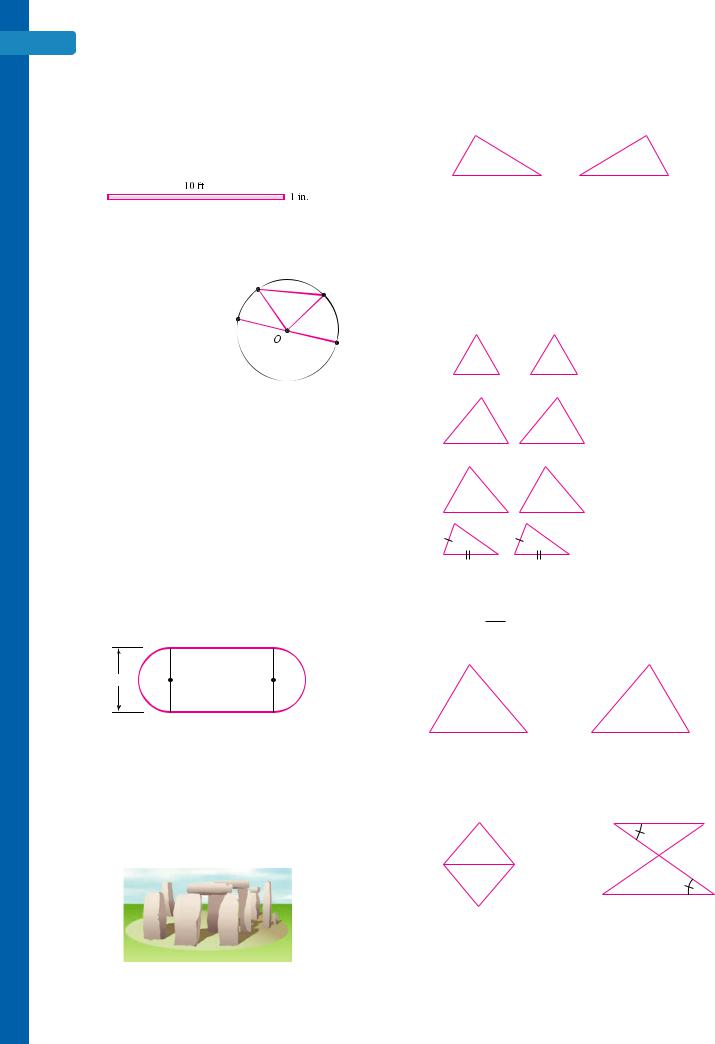
836 |
Chapter 9 Test |
21.How many square inches are in one square foot?
22.Find the area of the rectangle shown below in square inches.
23.Refer to the figure below, where O is the center of the circle.
a. |
Name each chord. |
R |
S |
||
b. |
Name a diameter. |
X |
c. |
Name each radius. |
Y |
24.Fill in the blank: If C is the circumference of a circle and D is the length of its diameter, then DC  .
.
In Problems 25–27, when appropriate, give the exact answer and an approximation to the nearest tenth.
25.Find the circumference of a circle with a diameter of 21 feet.
26.Find the perimeter of the figure shown below. Assume that the arcs are semicircles.
20 ft
12 ft
20 ft
27.HISTORY Stonehenge is a prehistoric monument in England, believed to have been built by the Druids. The site, 30 meters in diameter, consists of a circular arrangement of stones, as shown below. What area does the monument cover?
28.See the figure below, where MNO RST. Name the six corresponding parts of the congruent triangles.
|
O |
|
|
|
|
|
|
T |
||||||
M |
|
|
|
N S |
|
|
|
|
|
|
|
|
|
R |
|
M |
|
|
|
|
|||||||||
|
MO |
|||||||||||||
|
N |
|
|
|
|
|
|
|
|
|
|
|||
|
|
|
|
|
|
|
|
|||||||
|
MN |
|||||||||||||
|
O |
|
|
|
|
|
|
|
|
|
|
|||
|
|
|
|
|
|
|
|
|
||||||
|
NO |
|||||||||||||
|
|
|
|
|
|
|
|
|
|
|
|
|
|
|
29.Tell whether each pair of triangles are congruent. If they are, tell why.
a.
5 yd |
5 yd |
5 yd |
5 yd |
5 yd |
5 yd |
||
b. |
|
|
|
39° |
53° |
39° |
53° |
7 cm |
7 cm |
||
c. |
|
|
|
62° |
|
62° |
|
57° |
61° |
57° |
61° |
d. |
|
|
|
81° |
|
81° |
|
30. Refer to the figure below, in which ABC DEF.
a. Find m(DE). |
b. |
Find m( E). |
|
C |
|
|
F |
6 in. |
7 in. |
|
|
60° |
50° |
|
|
A |
B |
E |
D |
8in.
31.Tell whether the triangles in each pair are similar.
a. |
b. |
29° |
|
|
43° 43°
43° 43°
29°
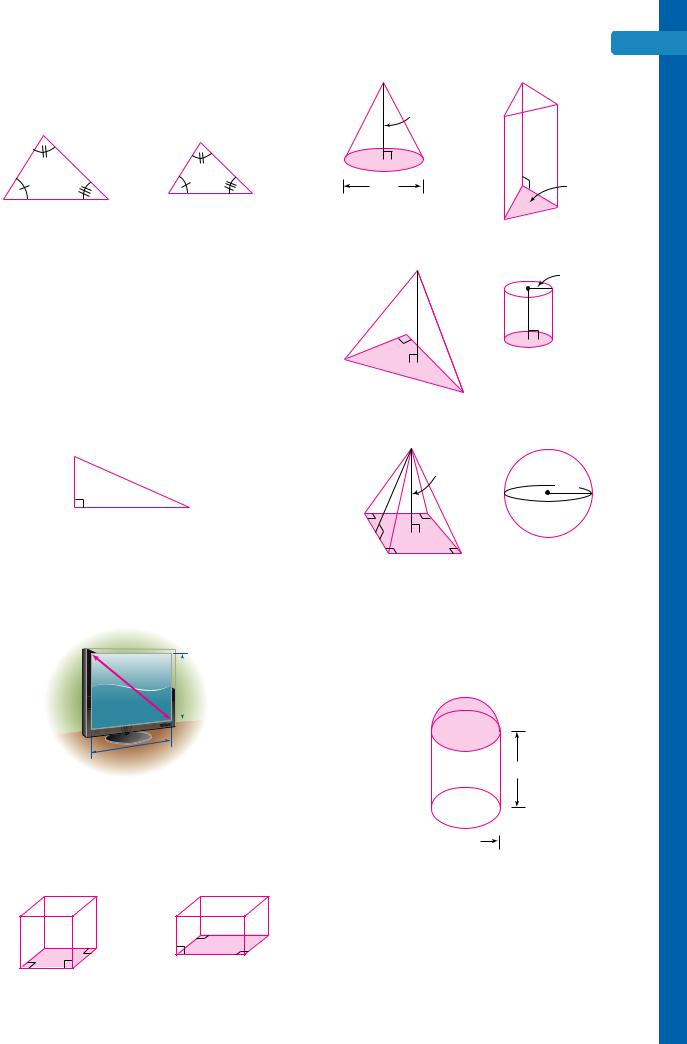
32. Refer to the triangles below. The units are meters.
a. Find x. |
|
b. |
Find y. |
|
C |
|
|
F |
|
|
|
|
|
|
6 |
y |
|
4 |
8 |
A |
B |
D |
x |
E |
|
|
|||
|
9 |
|
|
|
33.SHADOWS If a tree casts a 7-foot shadow at the same time as a man 6 feet tall casts a 2-foot shadow, how tall is the tree?
34.Refer to the right triangle below. Find the missing side length. Approximate any exact answers that contain a square root to the nearest tenth.
a.Find c if a 10 cm and b 24 cm.
b.Find b if a 6 in. and c 8 in.
c
a
b
35.TELEVISIONS To the nearest tenth of an inch, what is the diagonal measurement of the television screen shown below?
d in. |
19 in. |
||
|
|
|
|
25 in.
36. How many cubic inches are there in 1 cubic foot?
Find the volume of each figure. Give the exact answer and an approximation to the nearest hundredth if an answer contains p.
37. |
38. |
8 m
6 m
6 m
6 m |
10 m |
6 m
|
Chapter 9 Test |
837 |
39. |
40. |
|
|
27 in. |
|
|
20 in. |
|
24 in. |
Area: |
|
|
30 in.2 |
|
41. |
42. |
3 yd |
27 ft |
|
7 yd |
20 ft
21 ft
29 ft
43. |
44. |
12 mi
4 in.
10 mi
10mi
45.FARMING A silo is used to store wheat and corn. Find the volume of the silo shown below. Give the exact answer and an approximation to the nearest cubic foot.
40 ft
 30 ft
30 ft
46.Give a real-life example in which the concept of perimeter is used. Do the same for area and for volume. Be sure to discuss the type of units used in each case.
